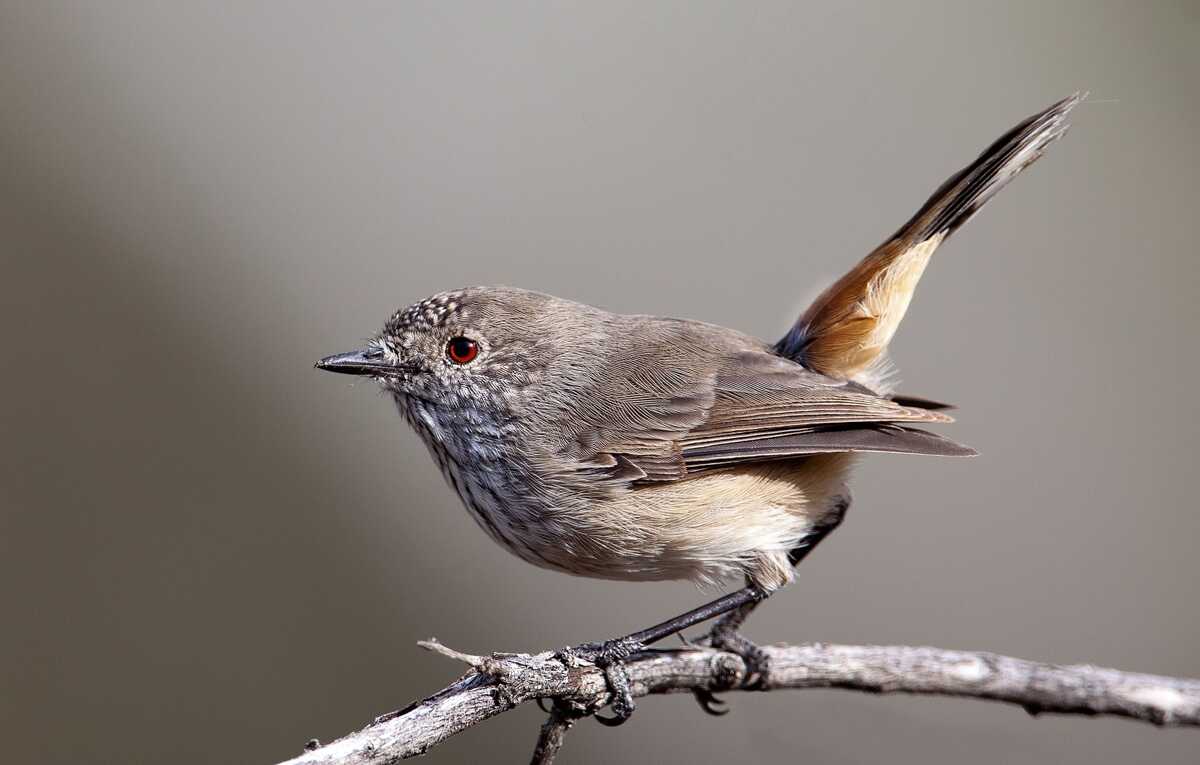{{{description}}}
(Pachycephala pectoralis) This bird is 15 to 18 cm long. Males have a bright yellow underside and nape, olive-green back and wings, a black head and chest-band, and a white throat. Females are dull brownish-grey. Both have a black bill, dark legs, and red-brown eyes. This bird lives in wooded habitat, feeds on berries, insects and spiders, and has a strong, musical voice. It breeds from September and January.
Image by Greg Miles
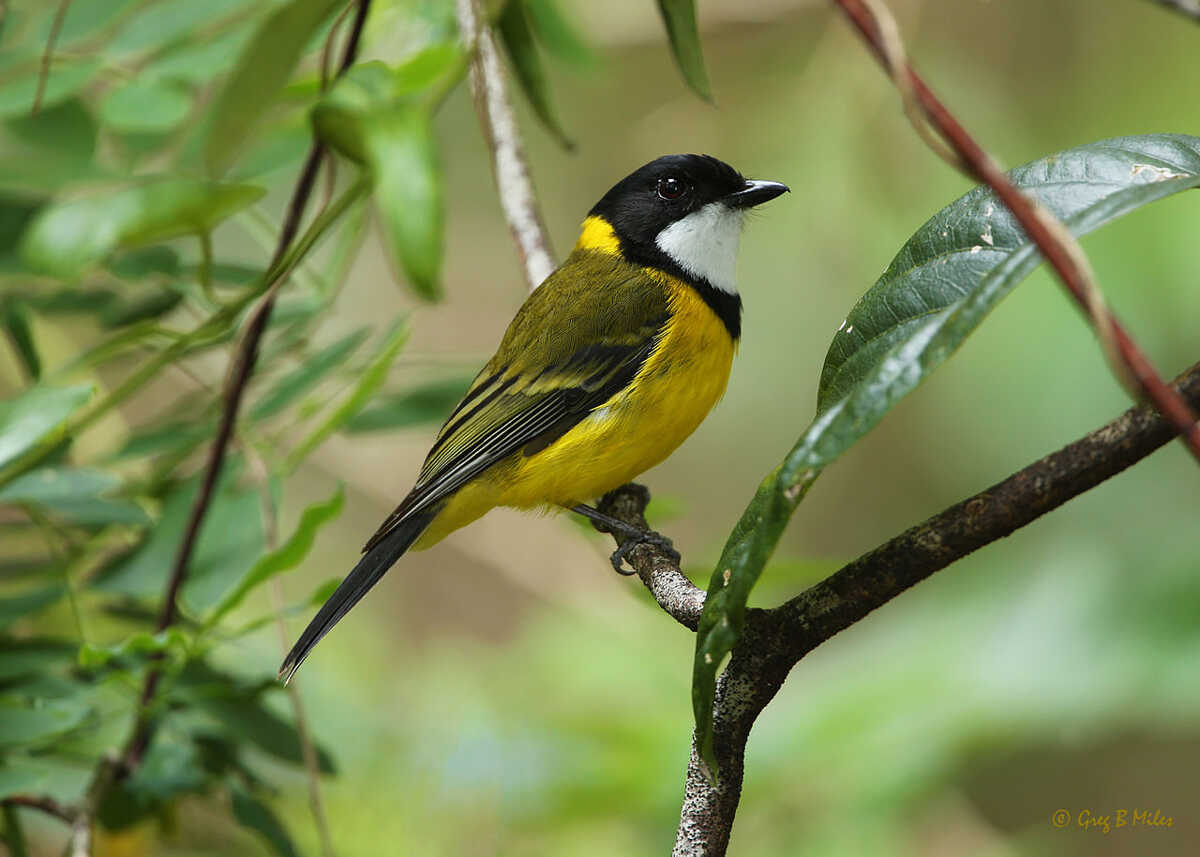
(Pachycephala rufiventris) This bird is found in Australia and New Caledonia. It is 16 and 18 cm long. Males have dark-grey plumage, white throats, and a black mask over their head and part of the neck. Females have dull brown or grey plumage with streaked underbodies. Both have short beaks and long narrow tails with sharp, forked tips. These birds produce a variety of musical calls.
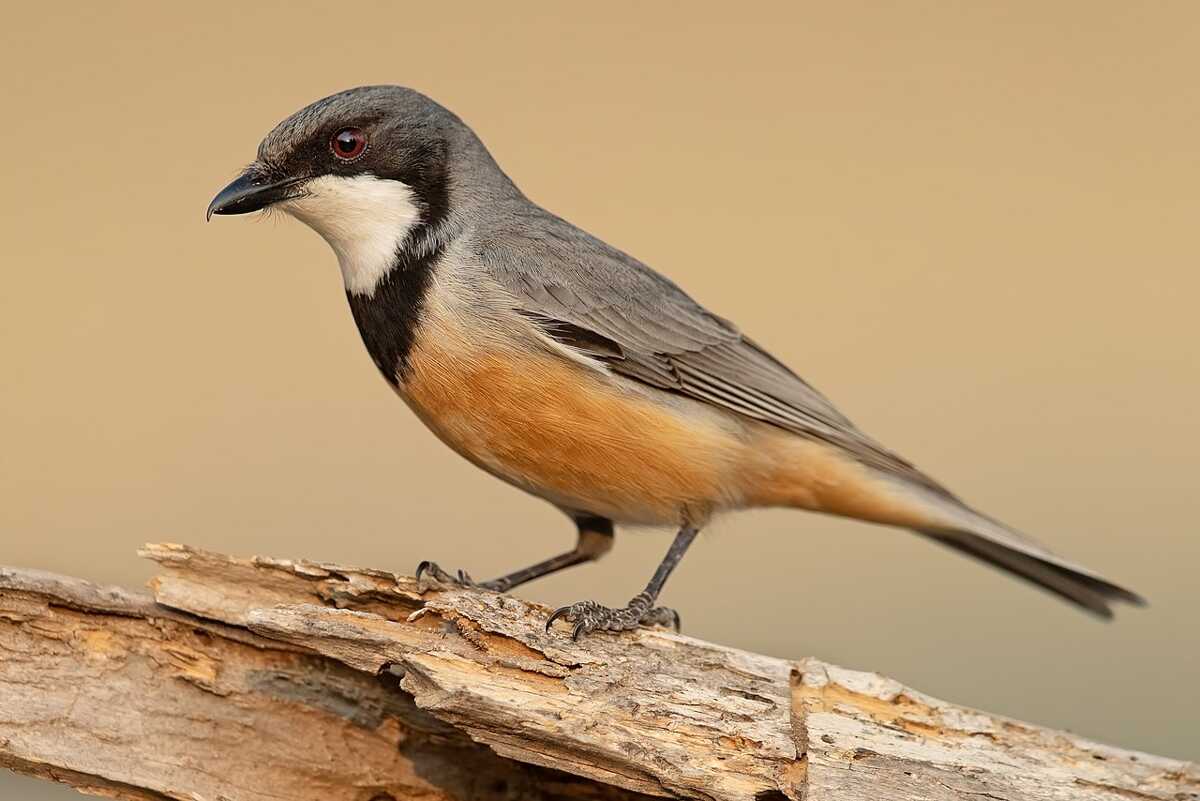
The magpie-lark (Grallina cyanoleuca) surprisingly has nothing to do with magpies or larks. It can be found in different biomes and environments all around Australia, excluding rainforests. The species is also known as "mudlark", "peewit" and "peewee". It's 25 - 30 cm long and boldly pied in black and white. Females have a white throat, while males have a black throat and a white "eyebrow". Learn more at https://en.wikipedia.org/wiki/Magpie-lark
Photo by Wayne Butterworth (CC BY 3.0)
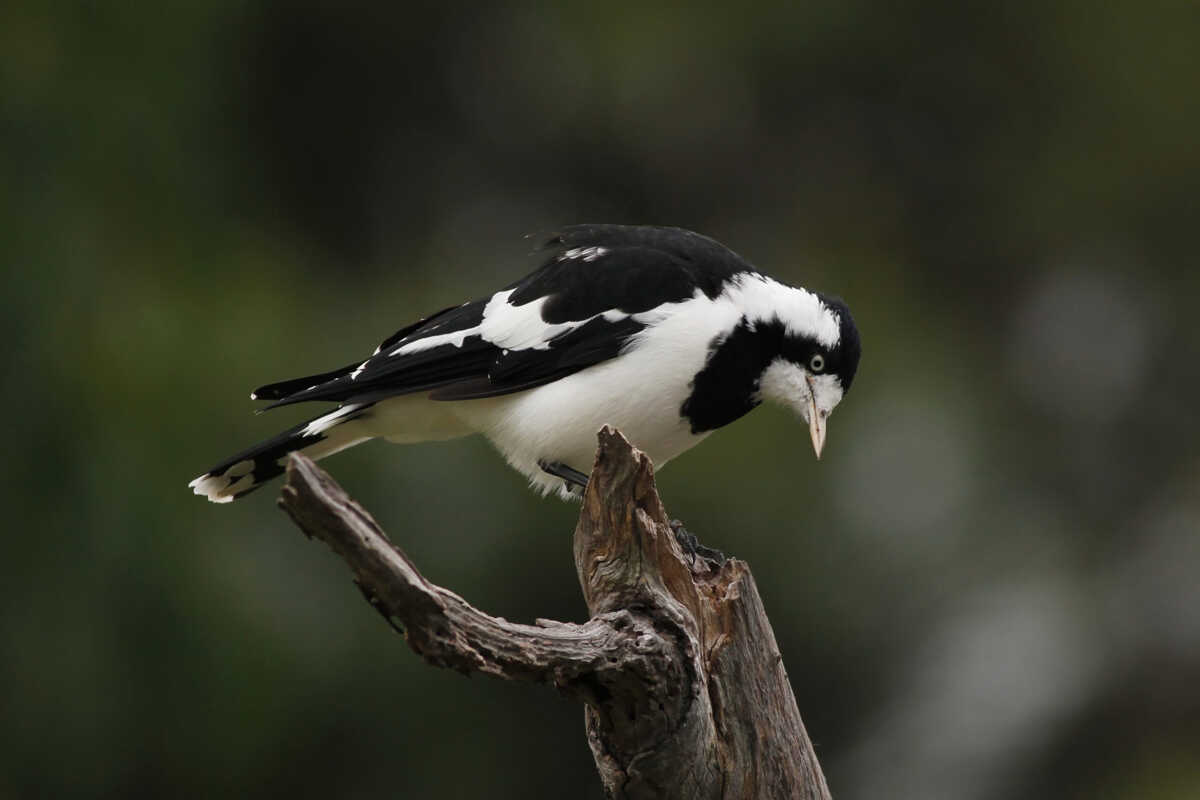
(Rhipidura leucophrys) This bird is native to Australia. It's 19 - 22 cm long. Its short black bill is tipped with a small hook. It has black legs and plumage, with a white eyebrow, "whiskers" and underparts.It has a number of distinct vocalisations with a rapid chit-chit-chit-chit as the most recognised one.
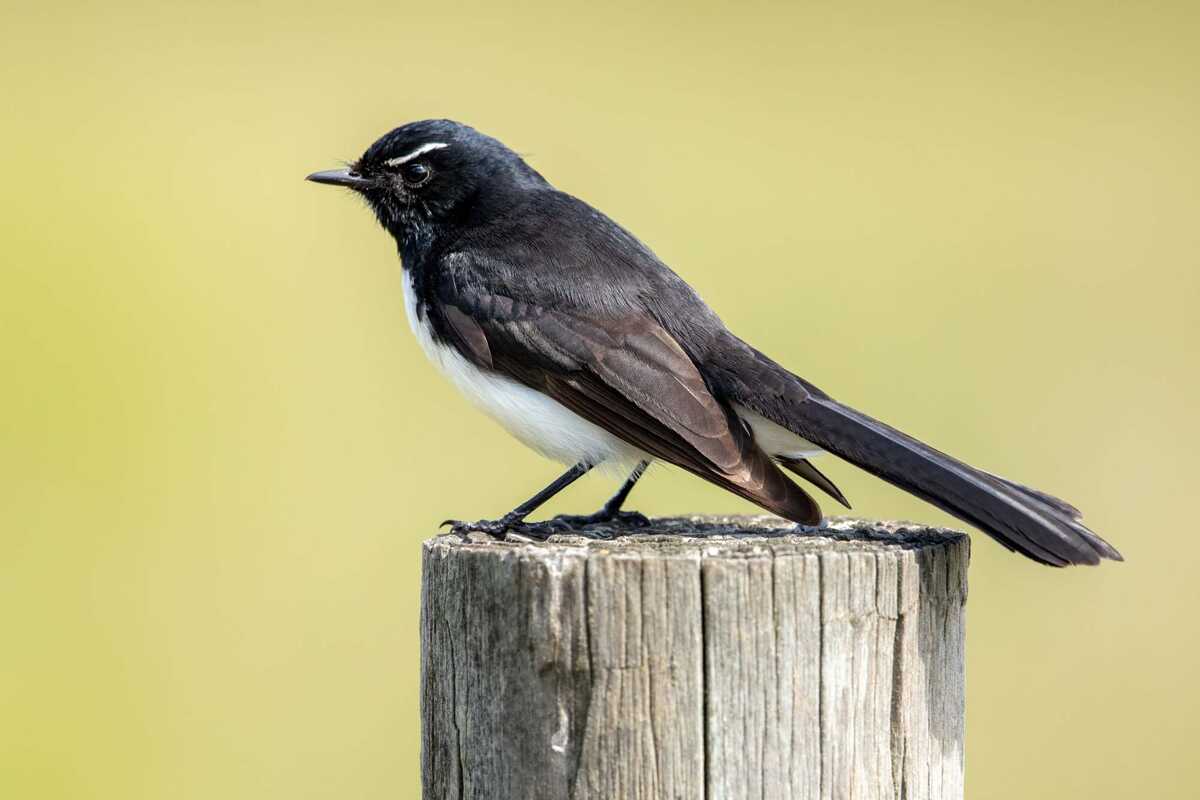
(Coracina tenuirostris) This is a medium-sized cuckoo-shrike. Males have dark-blue/grey plumage with black bills and dark legs. Females have brown-grey plumage above and a white underside with fine black lines. They have a horizontal dark eye stripe.
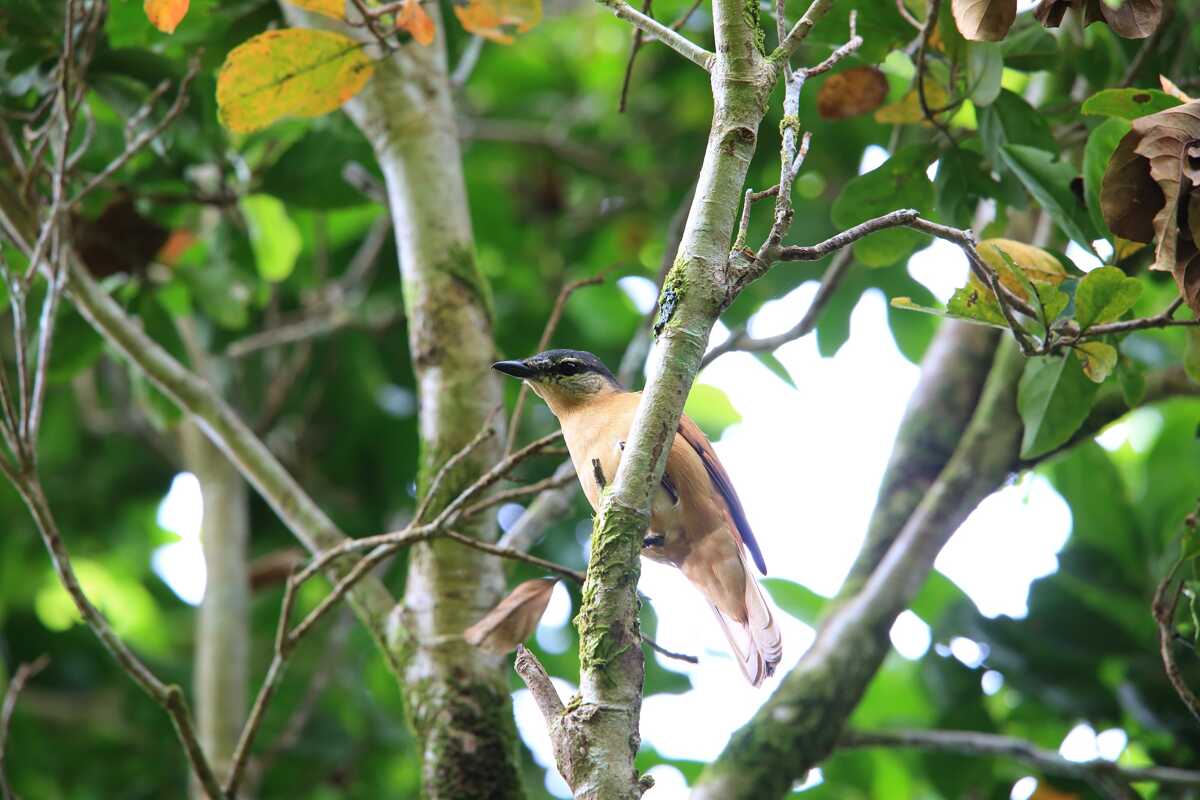
(Cracticus torquatus) This bird is endemic to Australia. It lives across southern Australia. It is 27–30 cm long and has a dark grey upper body with streaks of narrow white bands. Its head, top and sides are black while the chin and throat are white. Its beak has a slight downward hook. Its upper tail is black and has narrow white tips, while the wings are grey with large areas of white above and mostly white below. It sings with a characteristic "rollicking" birdsong.
Image by Ron Knight

(Gymnorhina tibicen) This bird is native to Australia and southern New Guinea. It is 37 - 43 cm long. Its plumage is of a very distinctive black and white colour. Its eyes are gold-brown eyes, and its wedge-shaped bill is white with a black tip. Males resemble females by different back markings - males have white feathers while females have white to grey feathers on the back of the head. It feeds on invertebrates and insects as well as small animals. It produces a large variety of complex calls and mimics other birds and even animals such as dogs and horses.

(Corvus coronoides) It's 46–53 cm long with all-black feathers, beak and mouth, strong grey-black legs, and feet. It has prominent throat hackles, which are in adult birds and white irises.
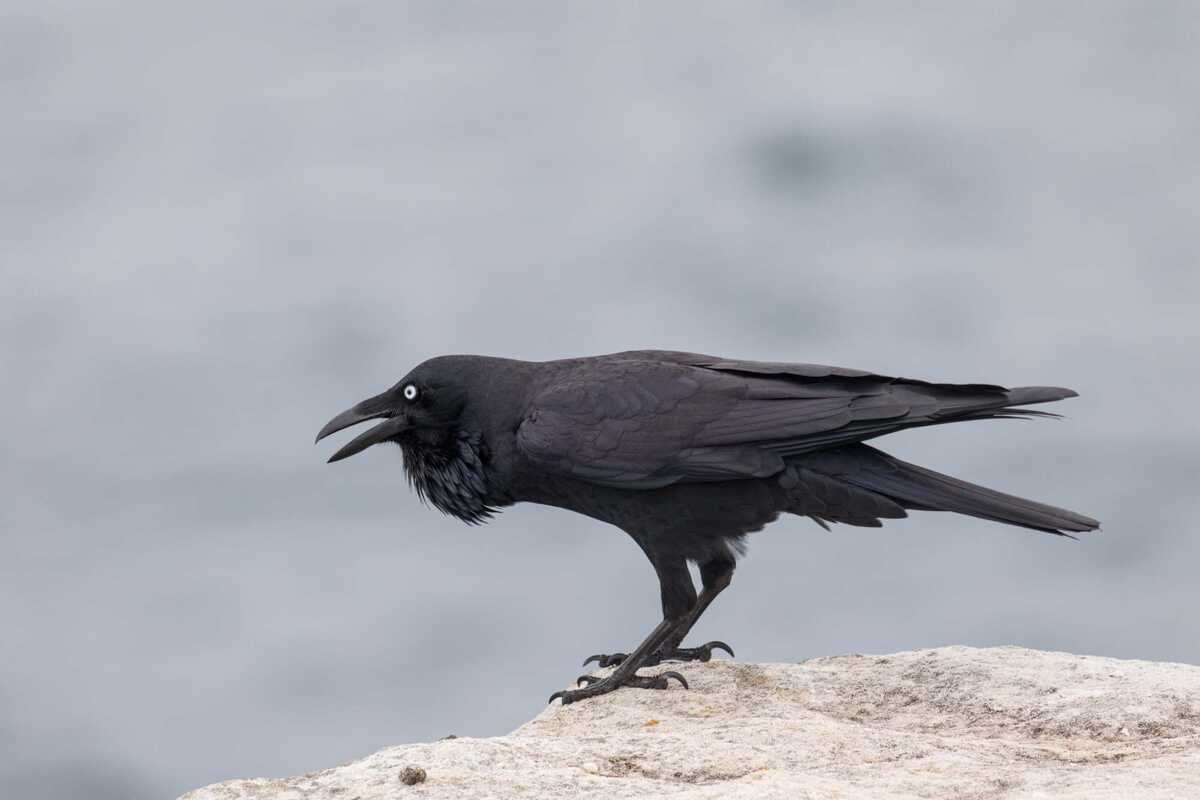
(Stizoptera bichenovii) Also known as Bicheno's finch or as the owl finch, this bird lives in dry savannah, tropical (lowland) dry grassland, and shrubland habitats of northern and eastern Australia. It is 10–11 cm long. Its white face is bordered with black. It has white underparts and brown upper parts and throat. It has a black line across its chest between the throat and underparts. It has brown and white wings. It feeds on fruits and lives in groups. It builds its nests in grass or bushes. The produce is a soft tet or a louder peew call. Learn more at https://www.birdlife.org.au/bird-profile/double-barred-finch
Image by John Harrison (CC BY-SA 4.0)

(Neochmia temporalis) This bird is found in temperate forests and dry savannah habitats on the eastern coast of Australia. It is 11–12 cm long and has a bright red stripe above the eye, as well as a bright red rump. Its plumage is grey, while wing coverts and collar are olive.

(Petrochelidon ariel) This migratory bird breeds in Australia during winter. It is usually found in open country near water. It is 12 cm long and has iridescent blue back plumage, brown wings and tail, a reddish crown and nape, and a whitish rump. The bottom feathers are dull white. Its call is a "chrrrr" and the song is a high-pitched twitter.
Image by Peter Jacobs
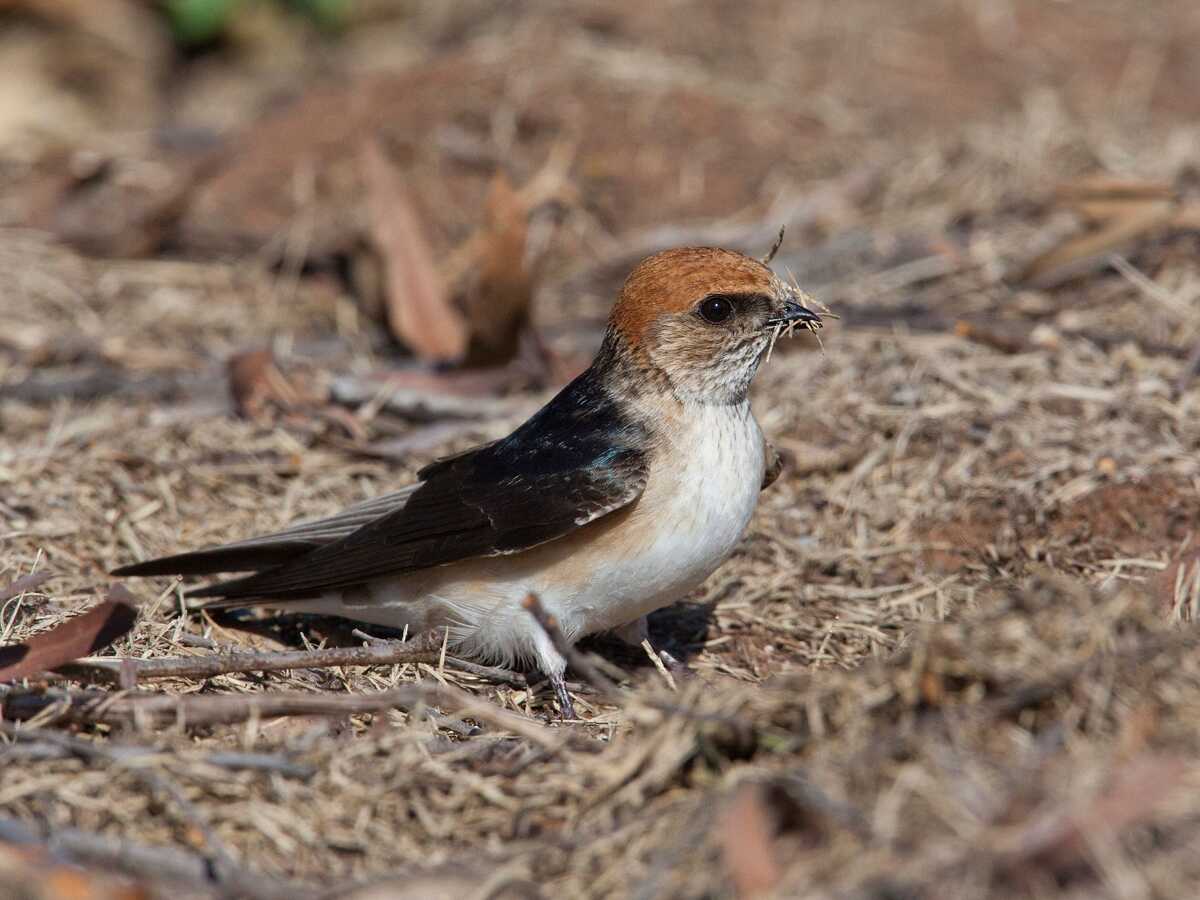
(Dromaius novaehollandiae) This flightless bird is the second-largest living bird by height (only beaten by the ostrich). It is the largest native endemic bird in Australia and lives in savannah woodlands and sclerophyll forests. It is 150-190 cm tall, has shaggy grey-brown plumage, pale blue neck and black shafts, and the tips of the feathers. It can sprint at 50 km/h. It feeds on a variety of plants and insects and breeds in May and June.
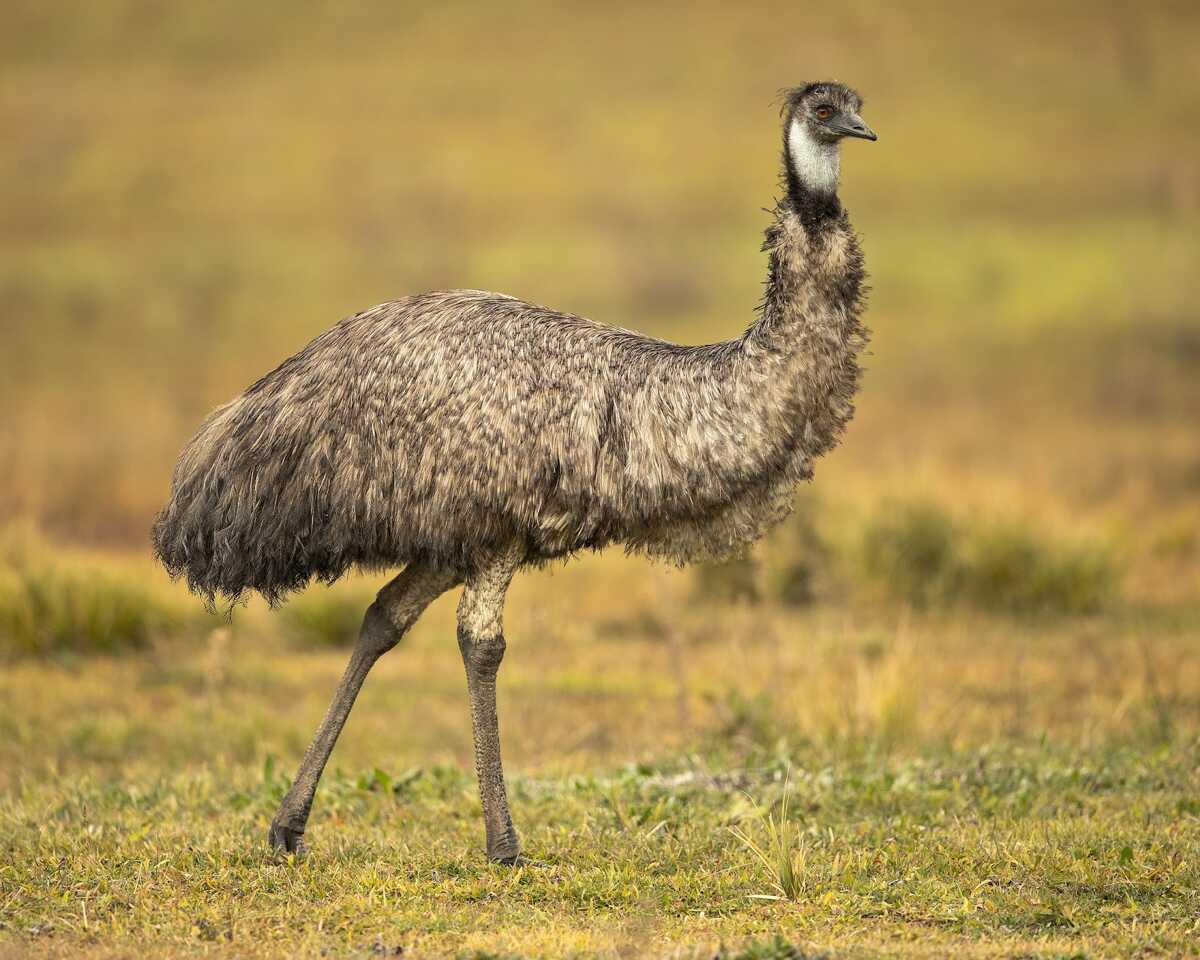
(Alectura lathami) This bird that lives in eastern Australia is also known as gweela, scrub turkey, or bush turkey. It is 60–75 cm long and has black upper plumage. Black is sprinkled with white feathers on the lower side of the body. The head is red. When breeding, males' heads and wattles become much brighter.

(Chenonetta jubata) It's 45–51 cm long and looks like a small goose, mostly feeding by grazing. Males are grey with a dark brown head and mottled breast. Females have white stripes above and below the eye and mottled underparts. They all have grey wings with black primaries and a white speculum.
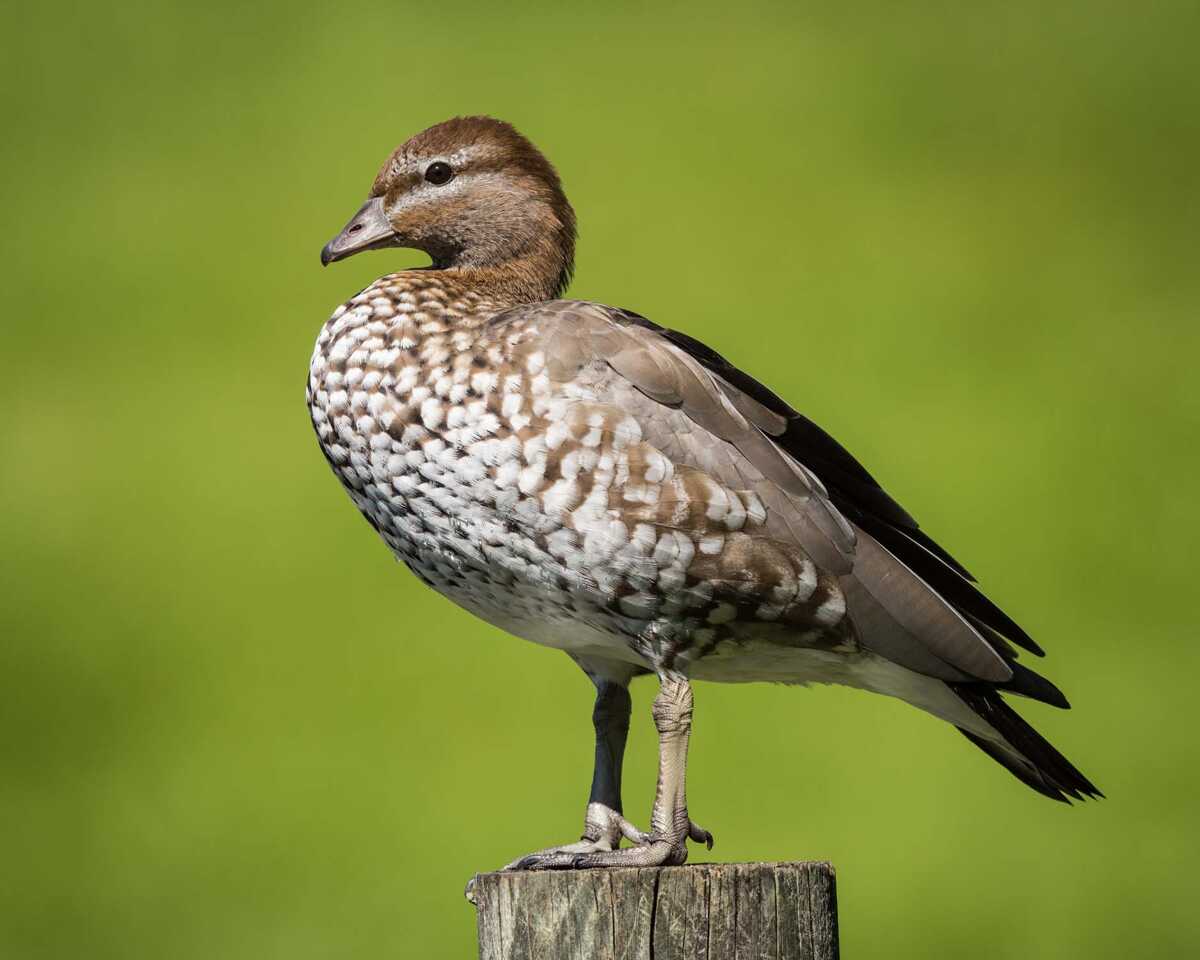
(Tachybaptus novaehollandiae) Australasian grebe is a small waterbird that is common on freshwater lakes and rivers all over Australia. With 25–27 cm in length, it is one of the smallest members of the grebe family. It has dark brown plumage with a glossy-black head and neck. A chestnut stripe extends from behind the eye to the base of the neck. Its eyes are yellow, as well as the pale face spot below the eye.
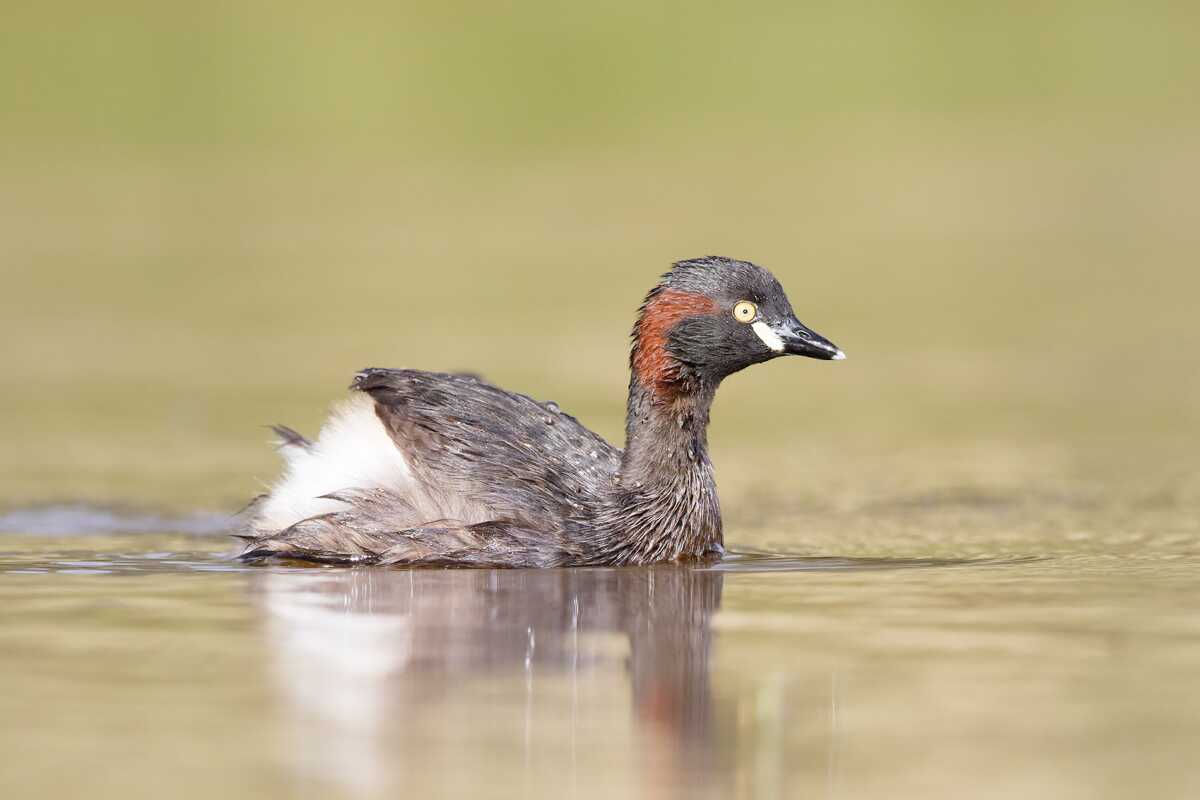
(Phalacrocorax sulcirostris) This bird is 60–65 cm and has black plumage, a grey bill, blue-green eyes, and black legs and feet. It lives in bodies of water inland and occasionally sheltered coastal areas and it feeds on fish.
Image by Moonlight0551
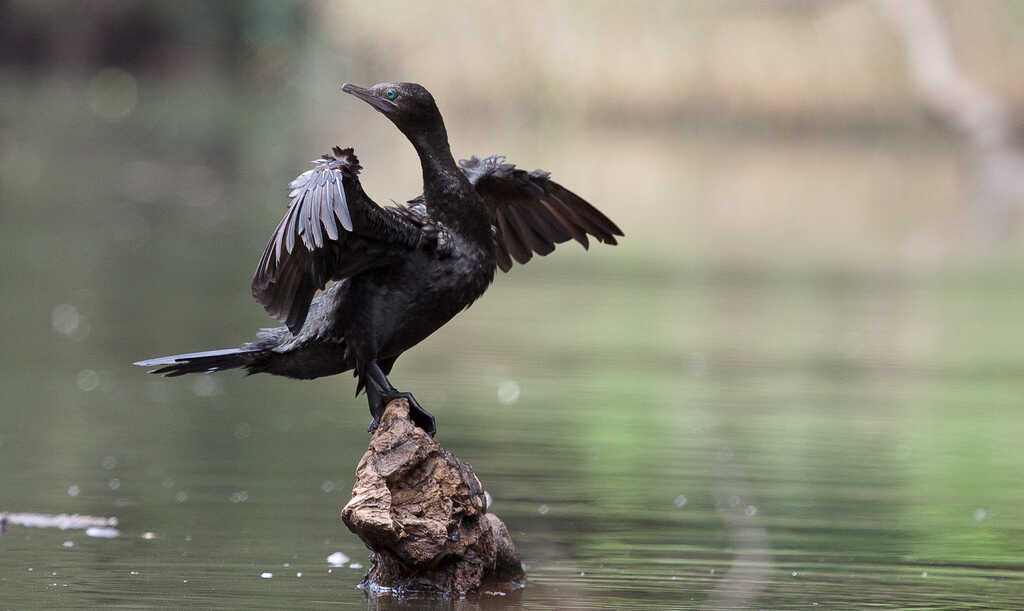
(Phalacrocorax carbo) This bird's name derives from Latinised Ancient Greek, phalakros stands for bald, corax stands for raven and carbo stands for charcoal. It is 70-102 cm long with black plumage, a longish tail, a light-coloured bill and a yellow throat-patch. While breeding adults have white patches on the thighs and throat.
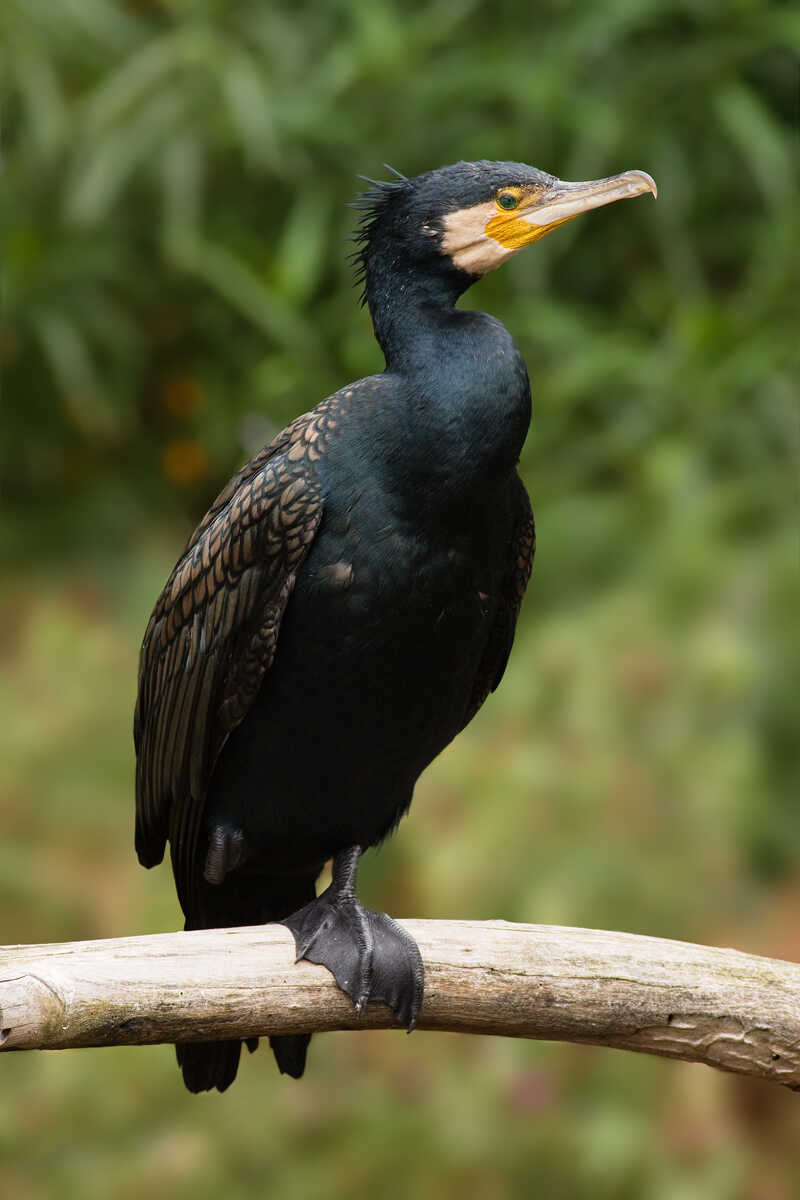
(Ardea alba) This large heron is up to 1 m tall, 80-104 cm long, and has a wingspan of 131-170 cm. It has all-white plumage, a yellow bill, and black legs and feet. While breeding the bill becomes darker and the lower legs lighter. During its (slow) flight its neck is retracted, and when walking it is extended and the wings are held close. It builds tree nests in colonies close to the water and feeds on fish, frogs, and small mammals.
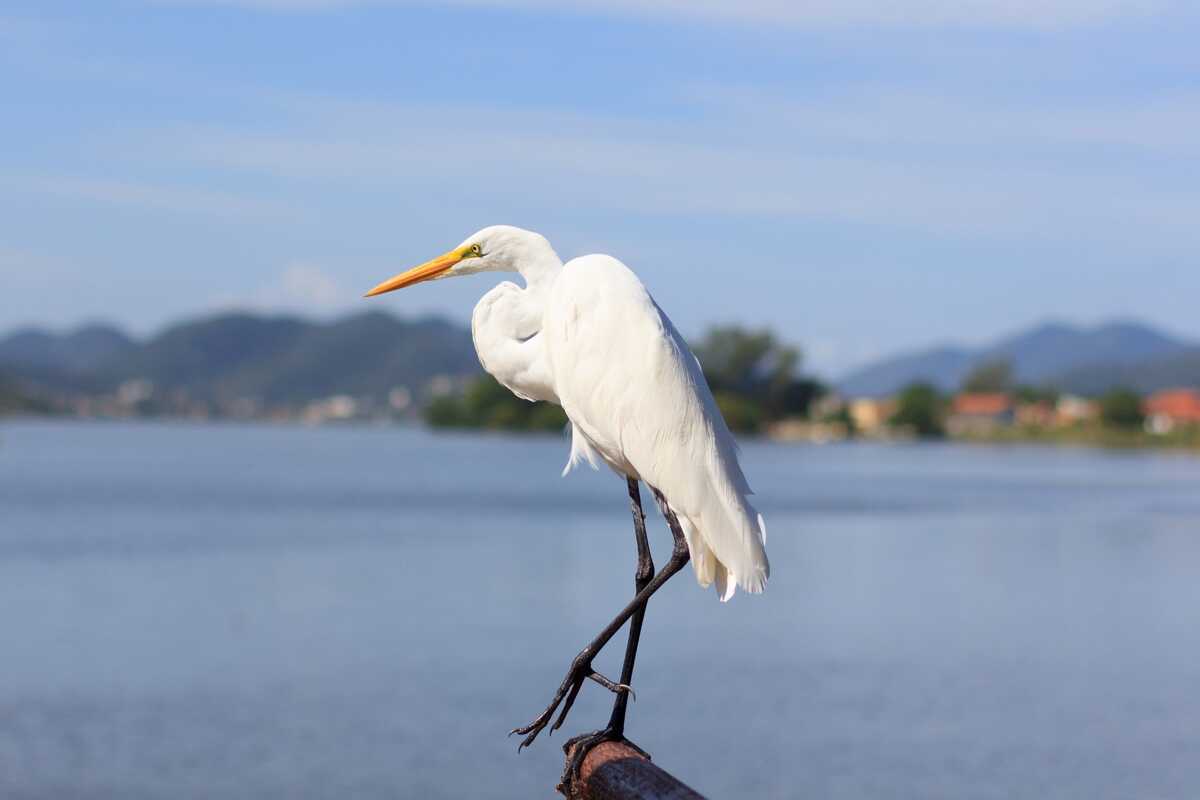
(Aviceda subcristata) Also known as crested hawk, crested baza, and Pacific cuckoo-falcon, this slender, medium-sized bird is 35–46 cm long. It has a grey upperside with brown scapulas. Its underside is white and barred with black. It has a slim grey head, round yellow eyes, reddish-brown thighs, and grey feet. Its long tail is square, tipped with black. It lives in forests, savannas, and freshwater bodies. Females have a slightly browner upperside.
Image by Stephen Michael Barnett
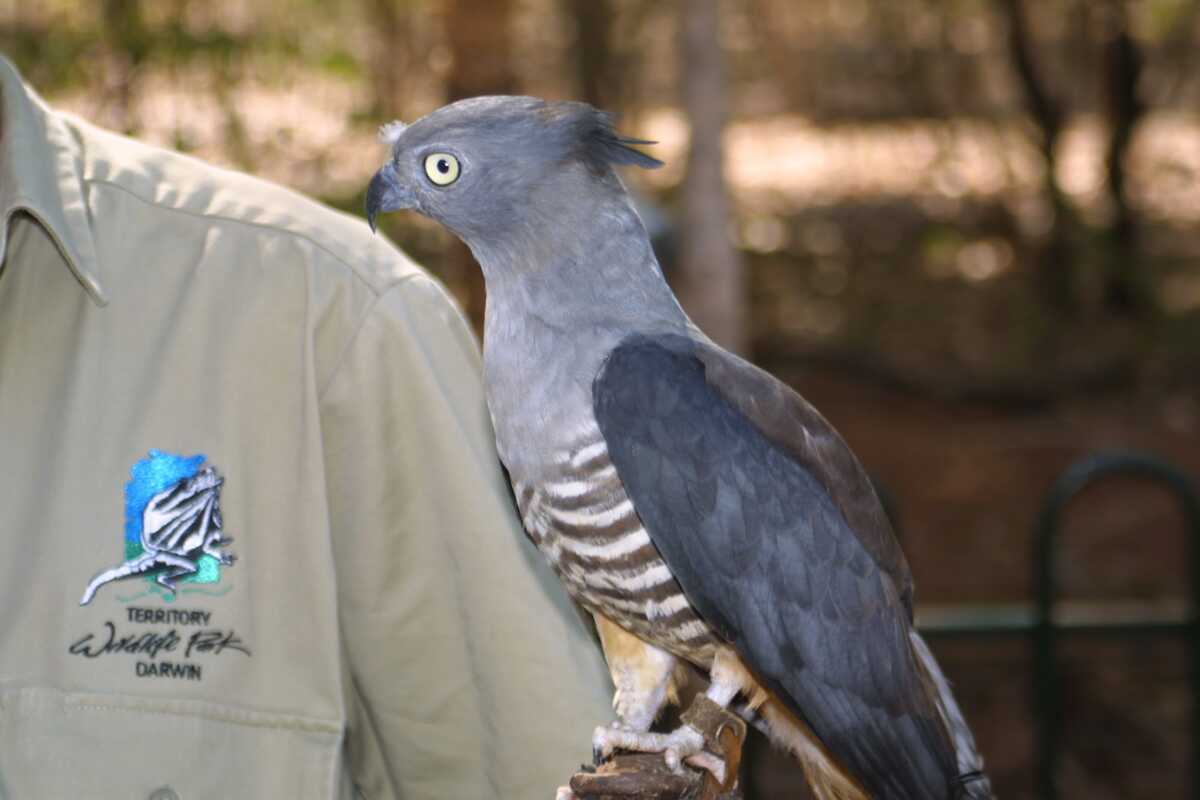
(Haliastur sphenurus) Also called whistling eagle or whistling hawk, this bird is named for its loud whistling call, which it makes while flying. This is most commonly a clear descending whistle, usually followed by a rapid series of rising notes. It is 50–60 cm long with a pale buff on its head, breast, and tail. It has brown wings and black flight feathers.
Image by Athena Ferreira
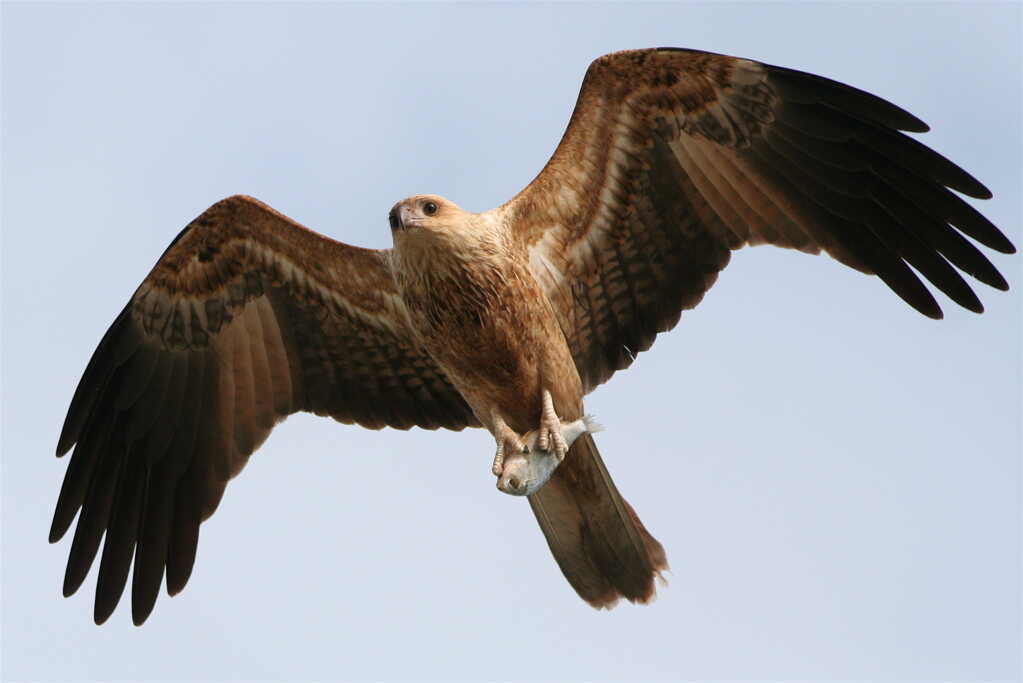
The wedge-tailed eagle (Aquila audax) can be identified by its wedge-shaped tail and is the largest living bird of prey in Australia. It is also one of the largest eagles in the whole world with a maximum wingspan of 2.84 metres. Can be spotted at high altitudes as well as in woodlands and rural areas. Learn more at https://en.wikipedia.org/wiki/Wedge-tailed_eagle
Photo by Donald Hobern (CC BY 2.0)

(Falco peregrinus) This bird is 34-58 cm long, females are about 30% larger in comparison to males. It has a black head, a yellow band around the eyes, and at the top of the black beak. Its upper plumage is bluish-black to slate grey, its underparts are white. Its long and narrow tail is rounded at the end and has a black tip with a white band. It has yellow feet.
Image by Christopher Watson
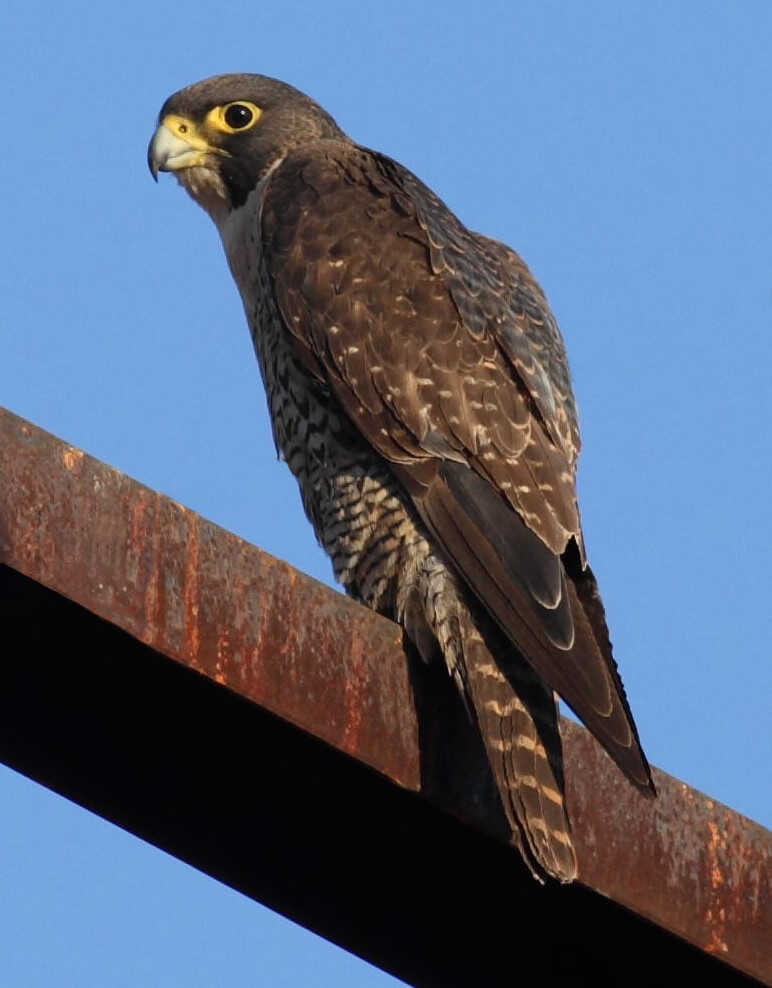
(Chalcophaps indica) Also known as green dove or as green-winged pigeon, this bird is 23–27 cm long and has bright emerald green back and wings. It has a dark pink head and underparts which turn greyish on the lower belly. It has brown eyes, a bright red bill and legs. Its feet are reddish, the flight feathers and tail are blackish. While flying, it shows black and white bars on its lower back. In comparison to females, males have a white patch on the edge of the shoulders and a grey crown.
Image by Sham Edmond
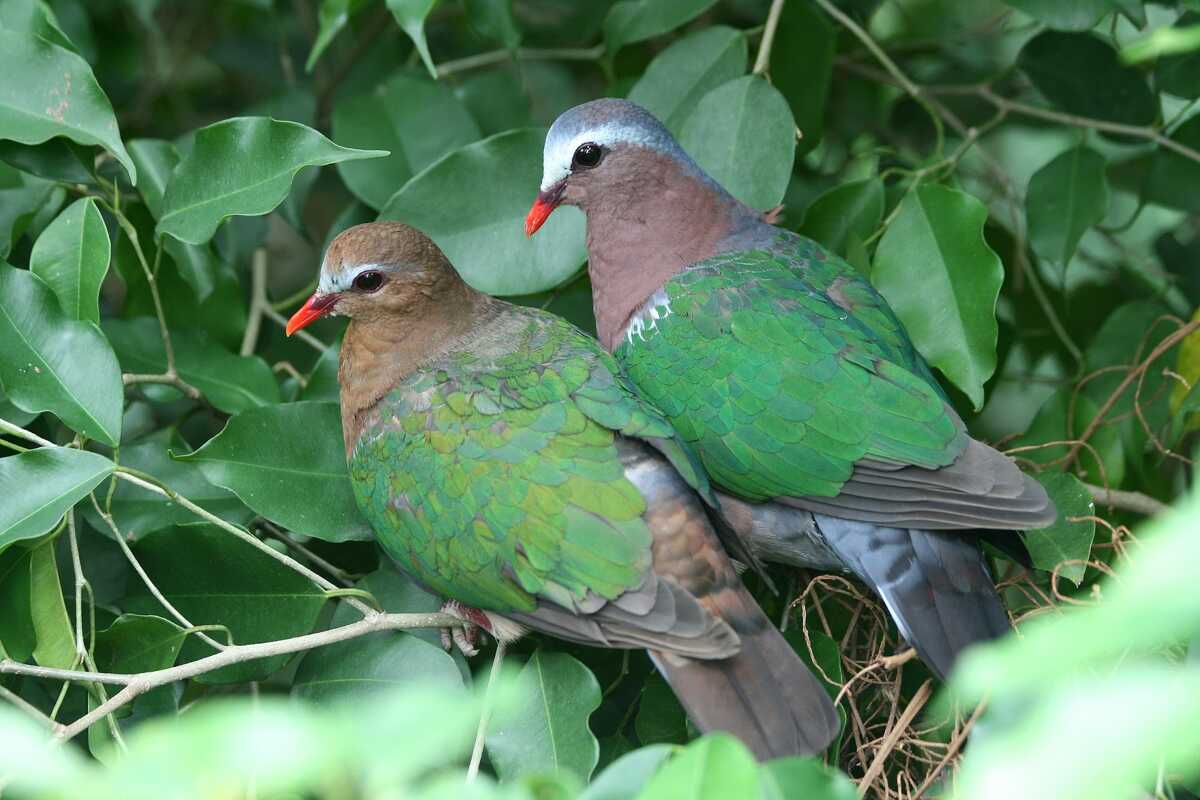
(Leucosarcia melanoleuca) It's 38 - 40 long with blue-grey back feathers, a white underside dotted with dark grey spots creating a distinct V pattern. Its head feathers fade to a creamy-white colour. Its eyes are a dark red-brown colour with pink eye-rings. It has red legs and a long tail.
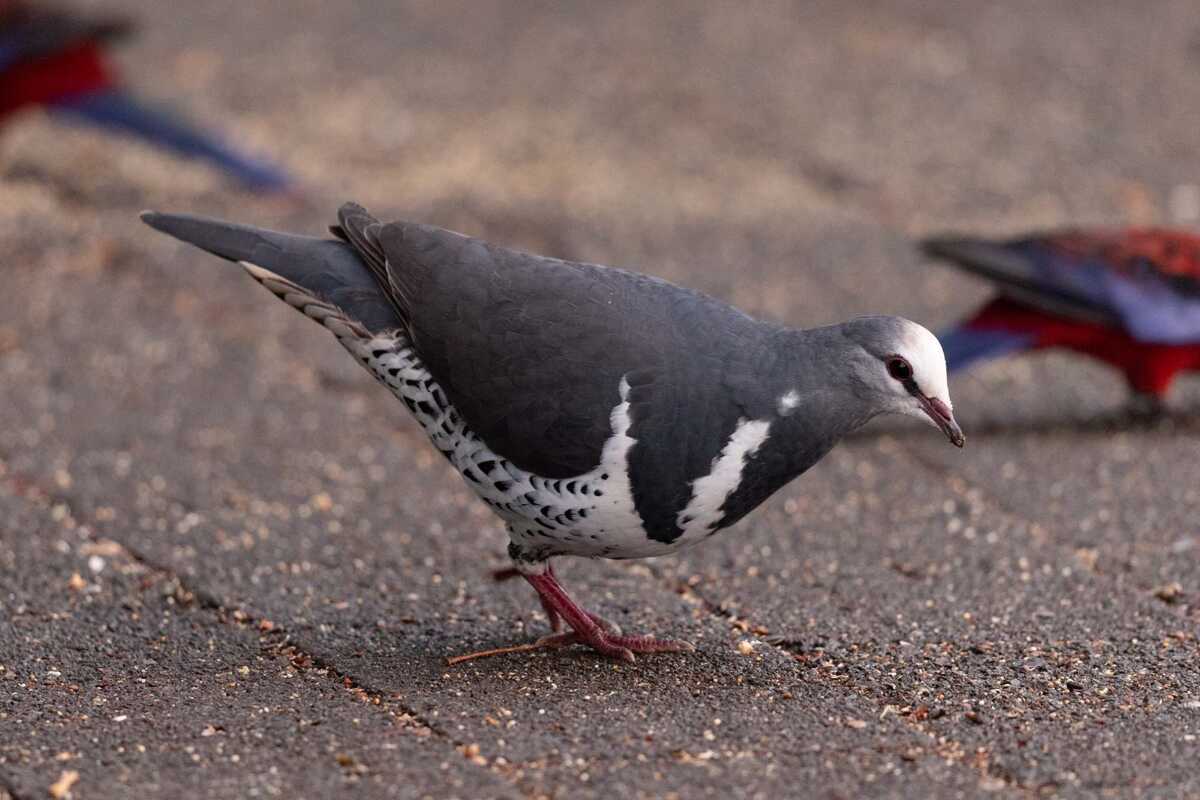
(Calyptorhynchus banksii) Also known as Banksian- or Banks' black cockatoo his bird got its name from the red lateral feathers in its tail. It is 60 cm long and covered in black plumage. Males have a prominent black crest along the forehead and crown, a dark grey bill, and a black tail with red lateral feathers. Females have yellow-orange stripes in the tail and chest, a pale bill, and fine yellow underparts over a black base. Learn more at https://birdlife.org.au/bird-profiles/red-tailed-black-cockatoo/
Image by Jean & Fred Hort (CC BY 2.0)
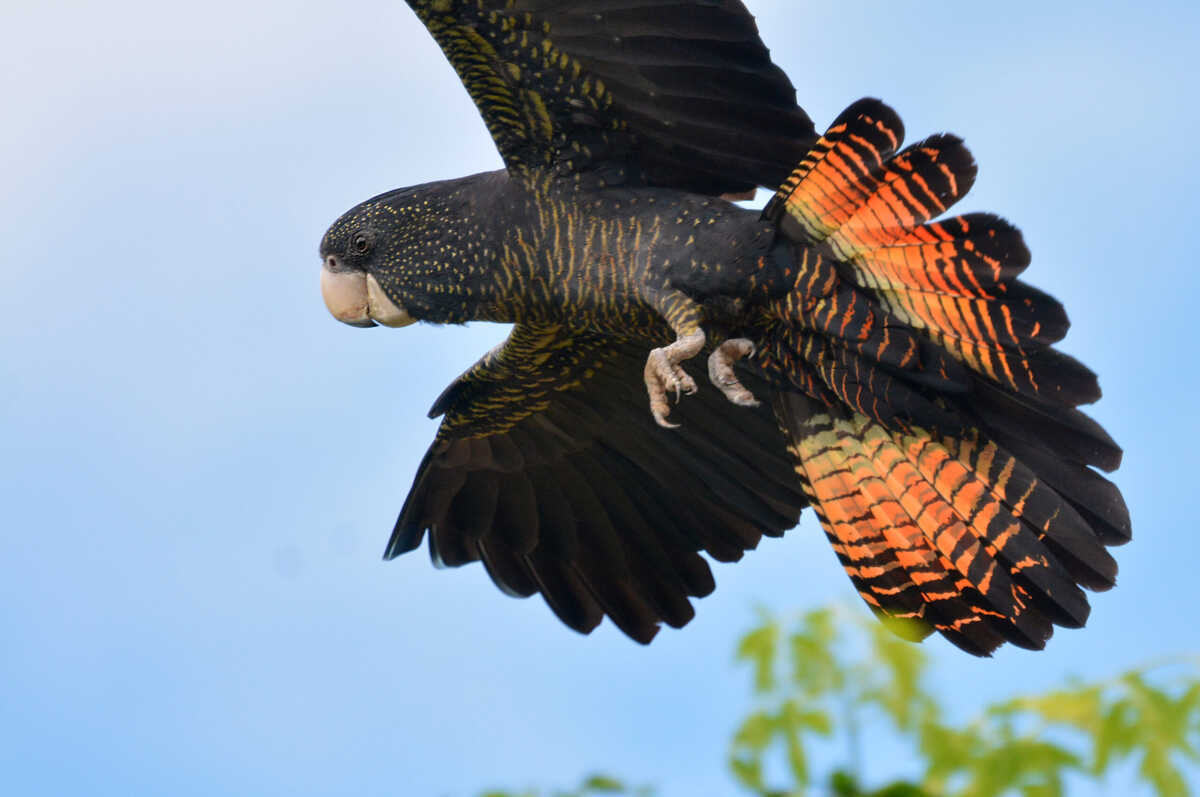
(Calyptorhynchus lathami) This bird is 46–50 cm long, has mostly black plumage, except the head which is chocolate-brown, and the red feathers in its tail (males have red bars while females have red patches). Females are dark brown and have flecks of yellow on the tail and collar. This bird usually feeds on seeds of the she-oak and lives in open forests and woodlands.
Image by Cabrils
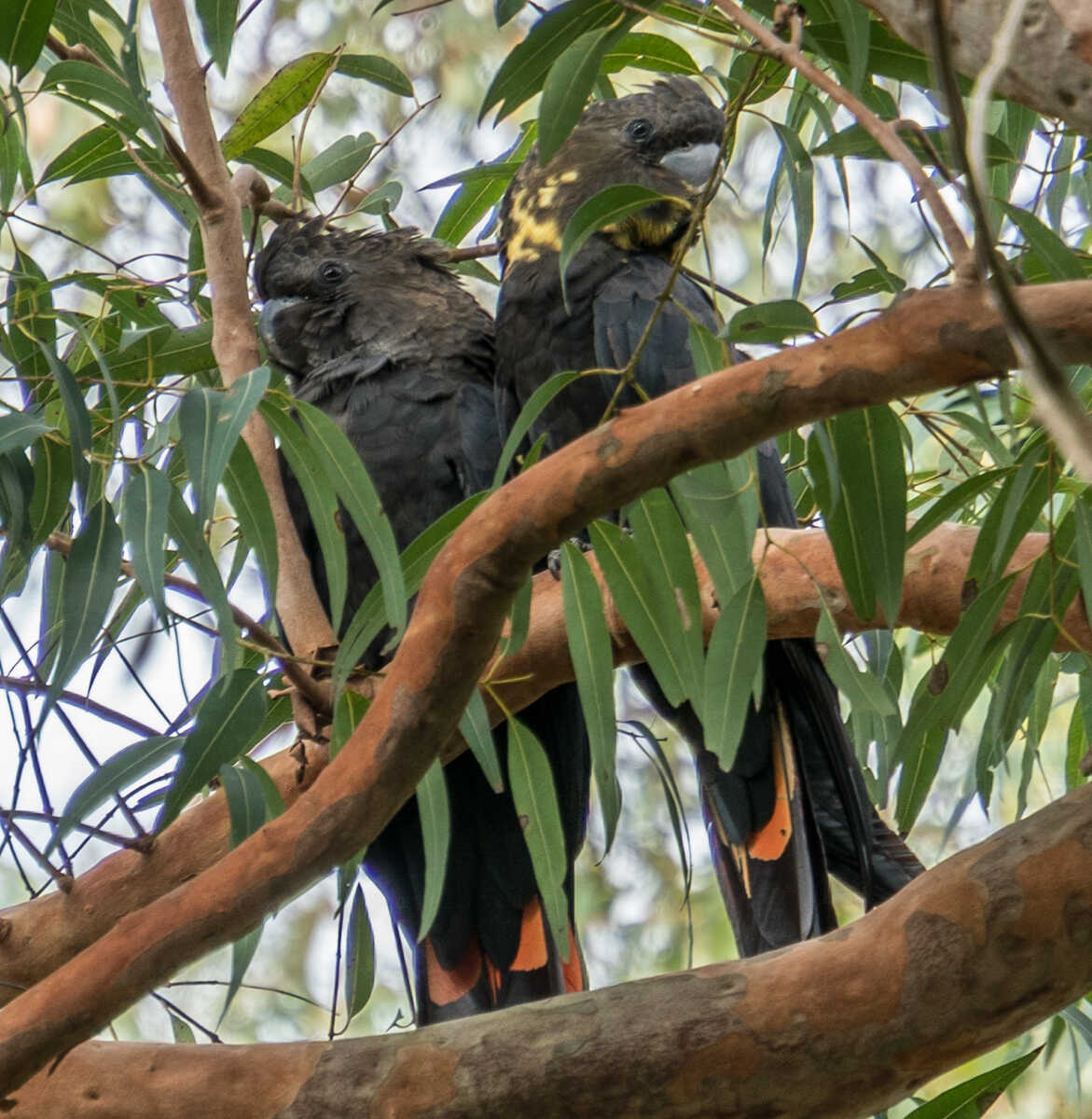
(Calyptorhynchus funereus) It's 55–65 cm long with a short mobile black crest, brownish-black plumage with paler feather margins in the neck, nape, and wings, and pale yellow bands in the tail feathers. Males have a black bill, a dull yellow patch behind each eye, and pinkish or reddish eye-rings while females have grey eye-rings, a horn-coloured bill, and brighter and more clearly defined yellow cheek patches.

(Eolophus roseicapillus) Galah is endemic to Australia. It's 35 cm long with a pale silver to mid-grey back, a pale grey rump, a pink face and chest, and a light pink mobile crest. It has grey legs, a light-coloured beak, and bare skin around the eyes. Males have very dark brown irises while females have mid-brown or red irises.
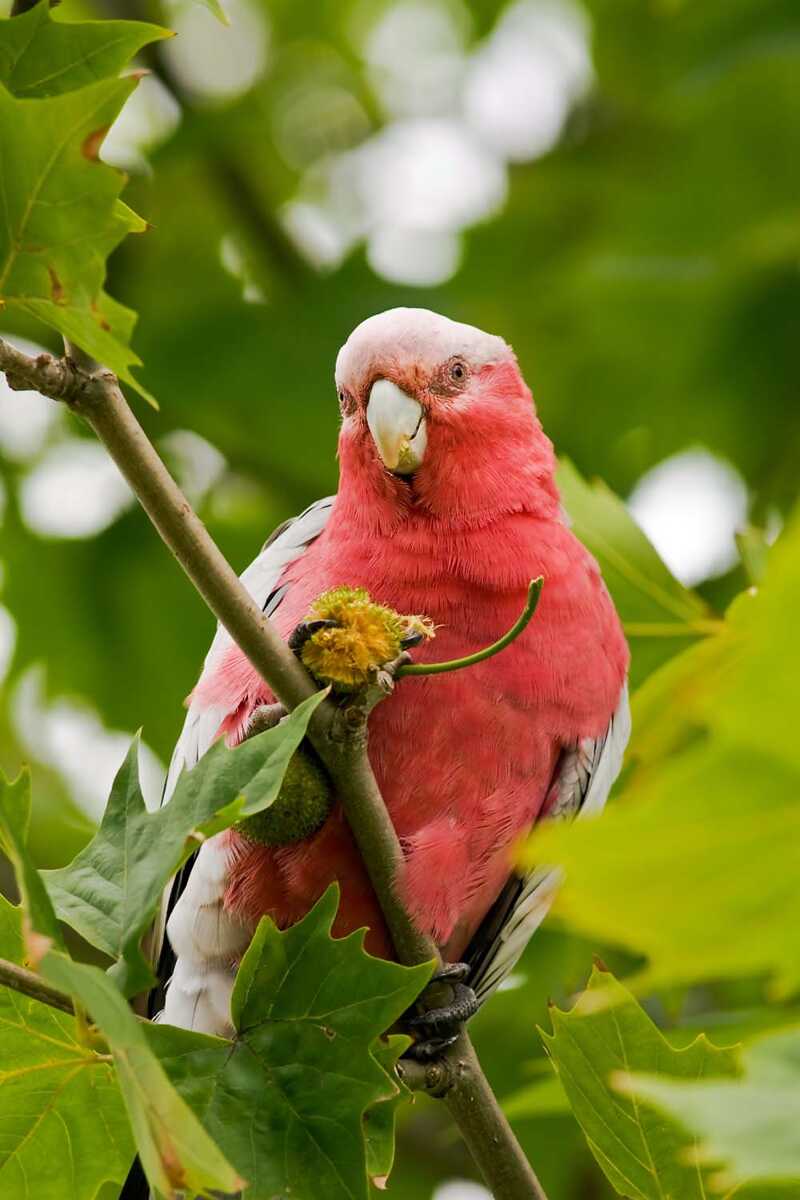
(Cacatua galerita) It's 44–55 cm long with white plumage and yellowish underwing and undertail. It has a yellow crest, a black bill, grey legs and whitish eye-rings. Males usually have almost black eyes, while females have red or brown eyes. Learn more at https://en.wikipedia.org/wiki/Sulphur-crested_cockatoo
Photo by Rob Russell (CC BY 2.0)
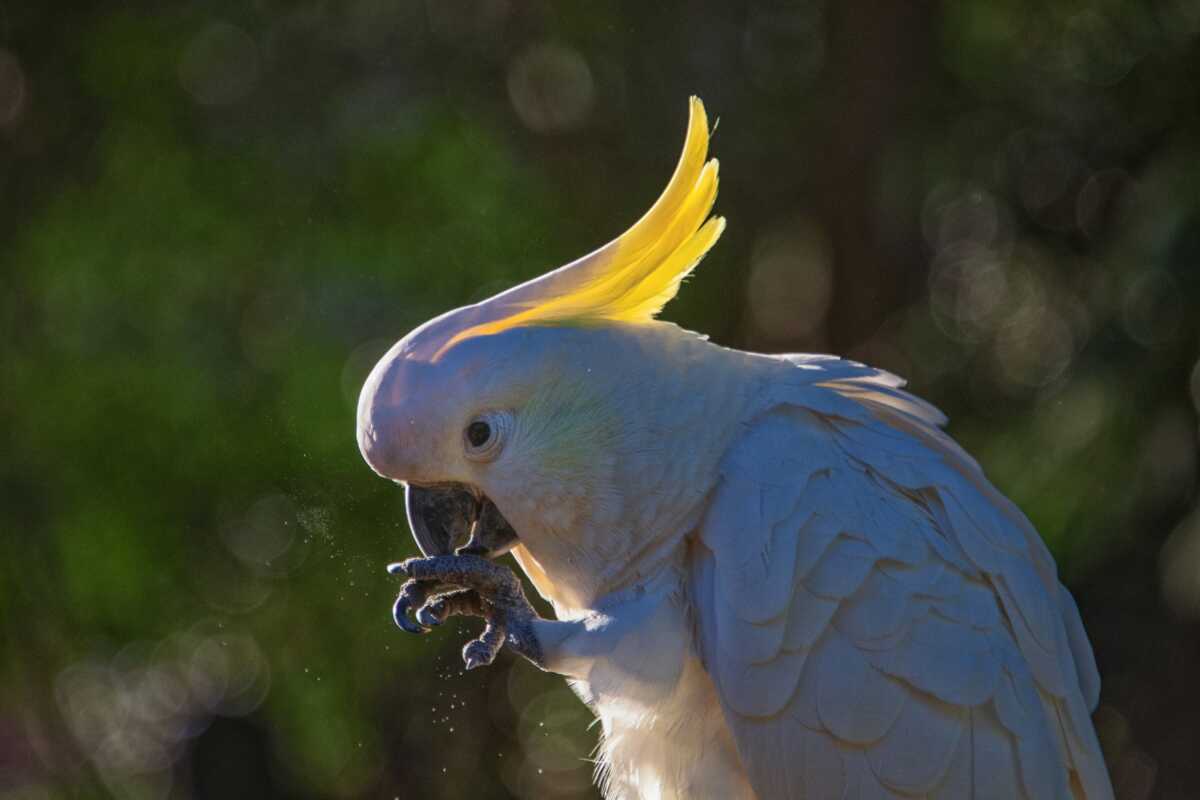
(Nymphicus hollandicus) Also known as weiro bird, or quarrion, this small parrot is endemic to Australia. It is 30-333 cm long and has a yellow (males) or grey (females) crest that is usually gently oblique but gets vertical when the bird is excited. Cockatiel's plumage is primarily grey with prominent white flashes on the outer edges of each wing. The sexes can be distinguished by the colour of their faces, with males being yellow or white, and females being grey. They both have a round orange area on both ears. They are relatively vocal birds.
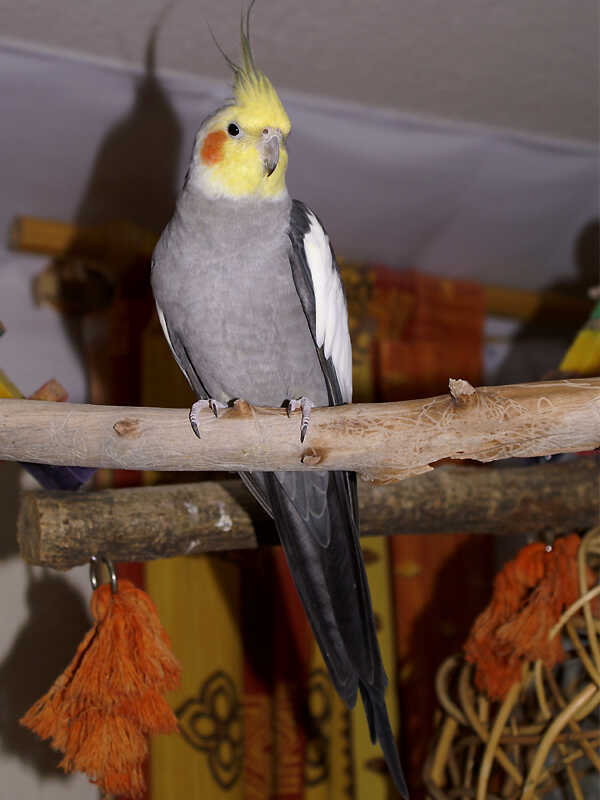
(Trichoglossus haematodus) It's 25 - 30 cm long with deep blue plumage on the head, a greenish-yellow collar, and green wings, back, and tail. Its chest is orange-yellow with a blue belly.

(Alisterus scapularis) This bird is endemic to eastern Australia. It lives in eucalyptus woods and subtropical and temperate rainforests and feeds on fruits and seeds. It is 43 cm long. Males have a red head, breast, and lower undersides, a blue band on the back of the neck, green wings and tail, and a blue rump. Females have a green head and breast, a grey beak, and a pale shoulder band that is small or absent.
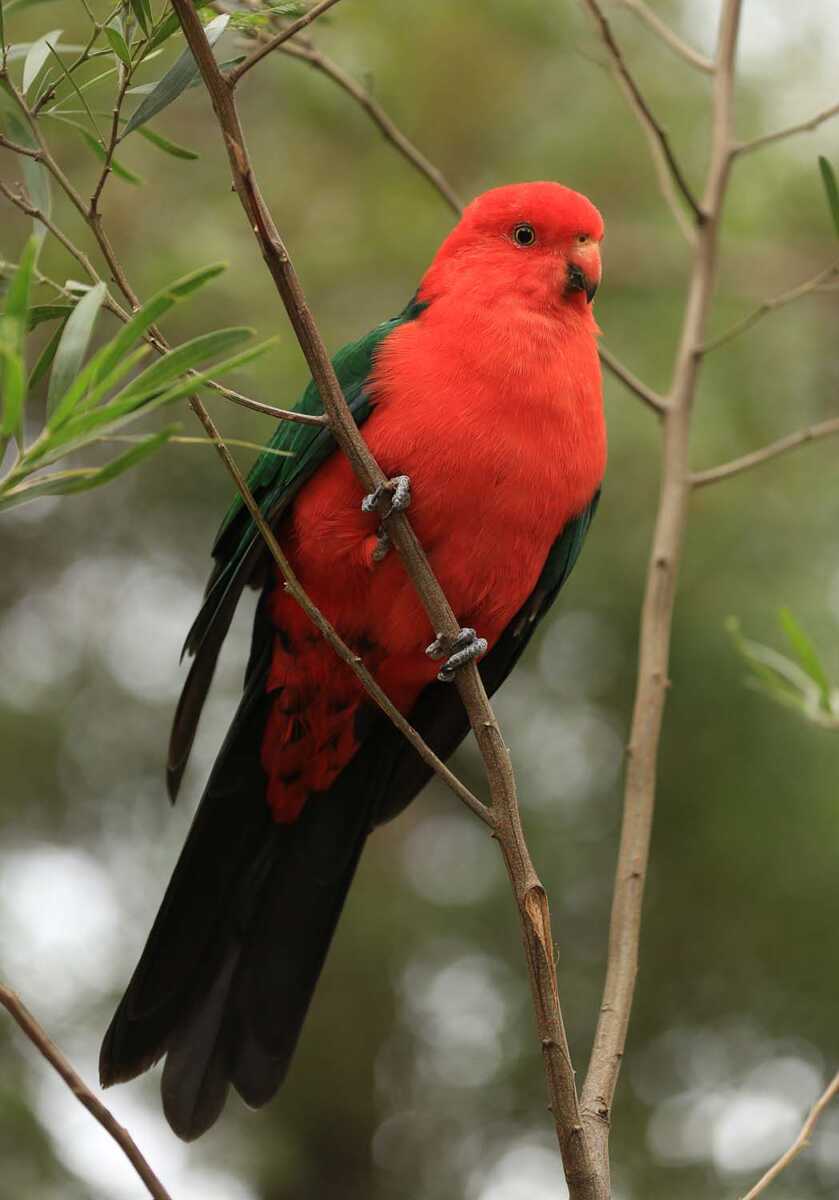
(Centropus phasianinus) This bird is 50-70 cm long with a black head and underparts, which moult to a white-streaked chestnut colour. It lives in subtropical or tropical moist lowland forests and subtropical or tropical mangrove forests. It makes a low descending 'boop boop boop' call. In winter, this is a sharp hissing sound.
Image by James Niland (CC BY 2.0)
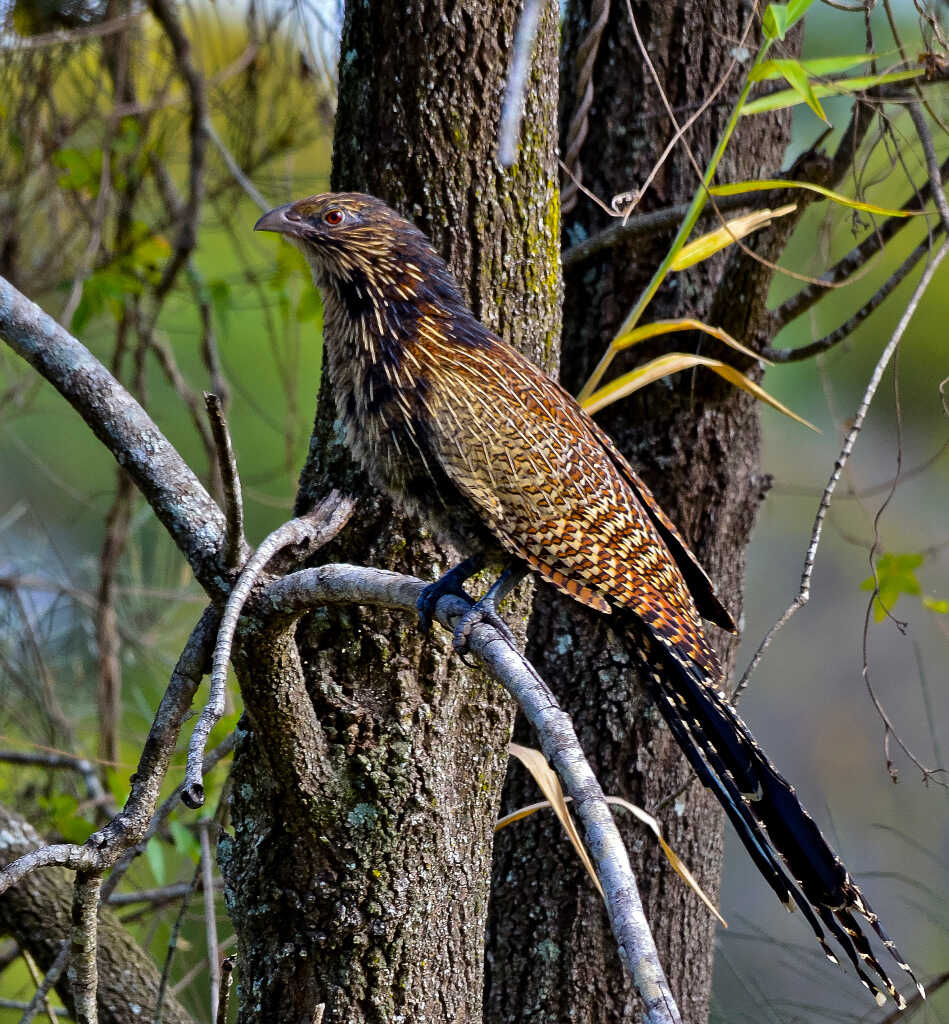
(Ninox strenua) This bird is native to SE and E Australia and is the largest owl on the continent. It's 45 to 65 cm long with a long tail with six narrow white bars, large yellow eyes, a protruding bill, and distinct brow ridges on a small head. The upperparts plumage is dark grey-brown, mottled, and barred with whitish. The underparts are white with bold grey-brown V-shaped barring.
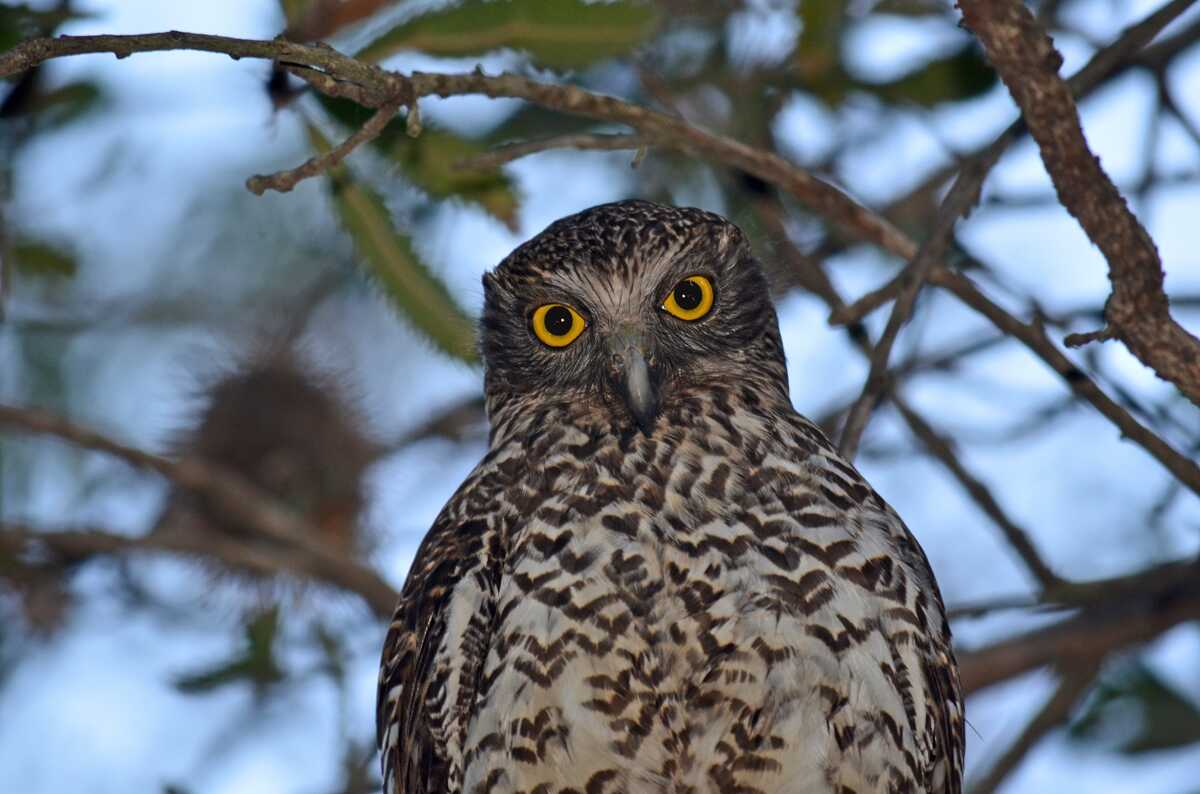
(Ninox connivens) Also known as the winking owl, this nocturnal medium-sized brown owl is native to mainland Australia and parts of New Guinea and the Moluccas. It is 39-44 cm long and has brown plumage with white spots on the wings as well as vertical streaks on the chest. It has large eyes with yellow irises and yellow skin on the feet. It has a characteristic voice, producing calls such as barking dog noise or a shrill human-like howl of great intensity.
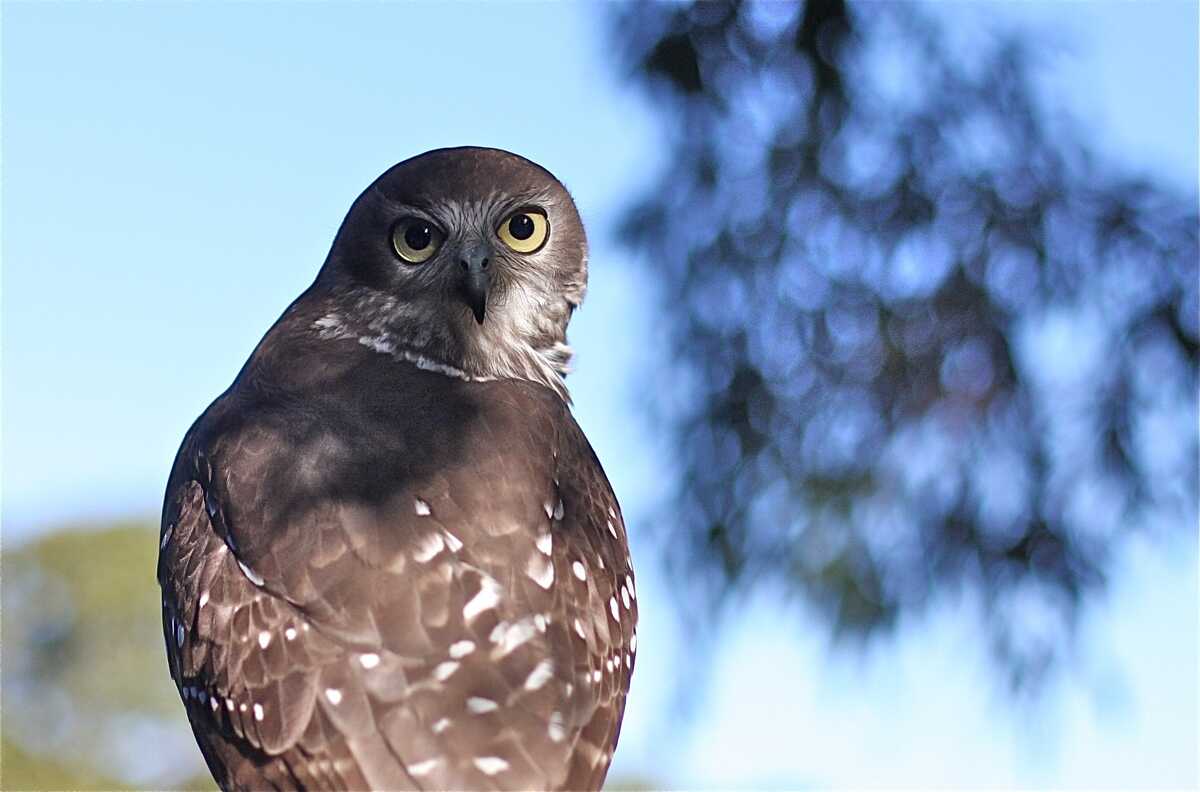
(Tyto alba) It is 33-39 cm long with long wings and a squarish short tail. It has a heart-shaped pale face, black eyes, and feathered legs. Its upper parts vary between pale brown and some shade of grey, and the underparts are white or reddish. Females are larger than males.
Image by Peter Trimming
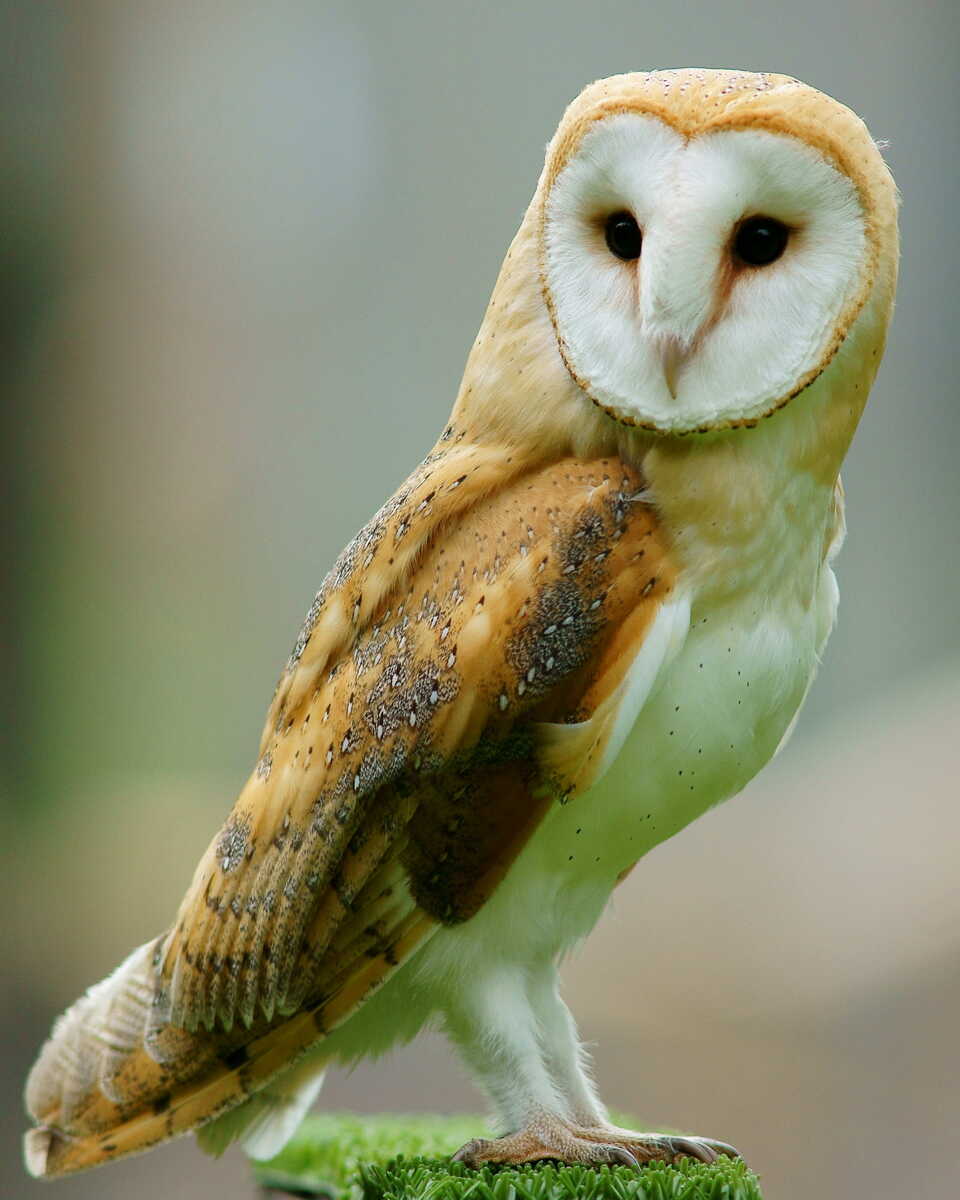
(Podargus strigoides) It's 34 - 53 cm long with grey plumage and a wide, heavy, olive-grey to blackish bill that is hooked at the tip and topped with distinctive tufts of bristles. Its eyes are large and yellow, which is why it's often mistaken for an owl. This bird is excellent in cryptic plumage and mimicry as they become practically invisible in broad daylight. Learn more at https://en.wikipedia.org/wiki/Tawny_frogmouth
Photo by Andrew Mercer (CC BY-SA 3.0)

(Dacelo novaeguineae) This bird is native to eastern mainland Australia. It is 41–47 cm long and has mostly dark-brown upper parts with a mottled light-blue patch on the wing coverts. It has cream-white underparts and a rufous and black-barred tail. It has a whitish head and a brown eye stripe. It produces a distinctive laughing sound.
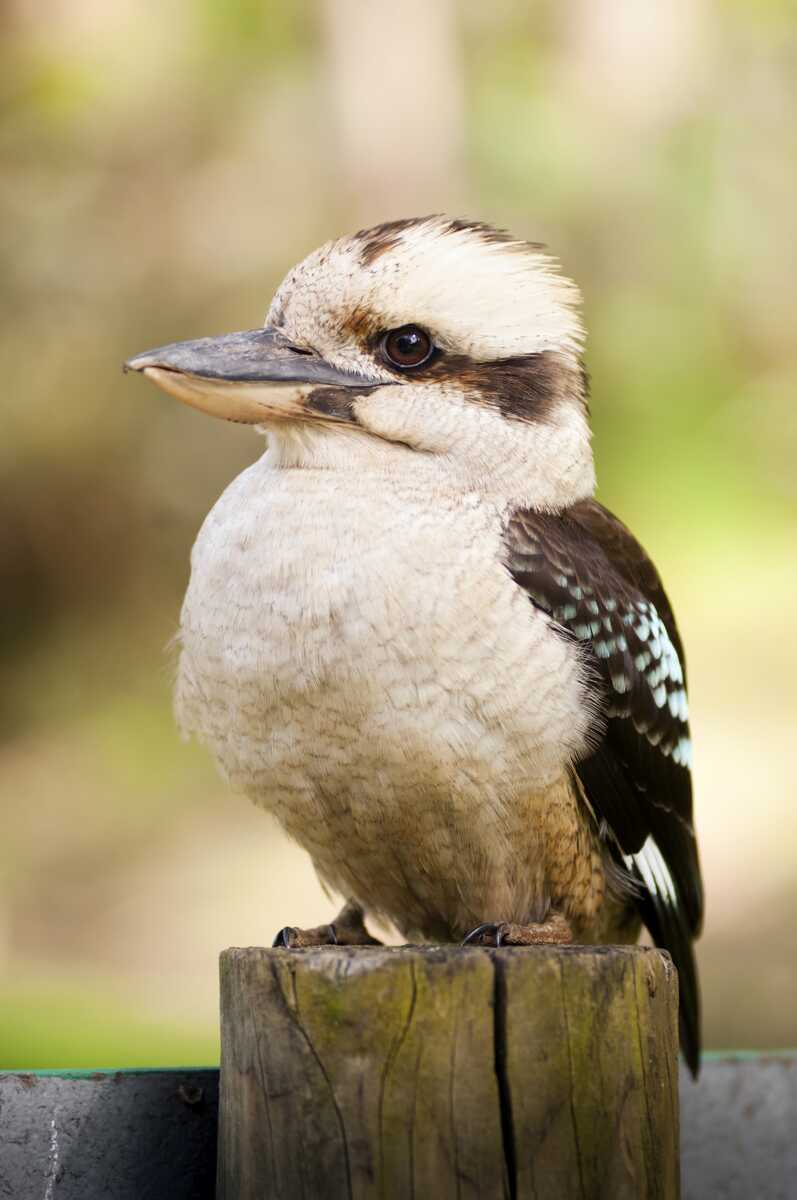
(Dacelo leachii) This bird is native to northern Australia. It is about 40 cm long and has blue wings, brown shoulders, and a blue rump. Its creamy plumage is barred with brownish markings. While males have a blue tail, females have a reddish one with black bars on it. Learn more at https://en.wikipedia.org/wiki/Blue-winged_kookaburra
Image by GDW.45 (CC BY-SA 3.0)
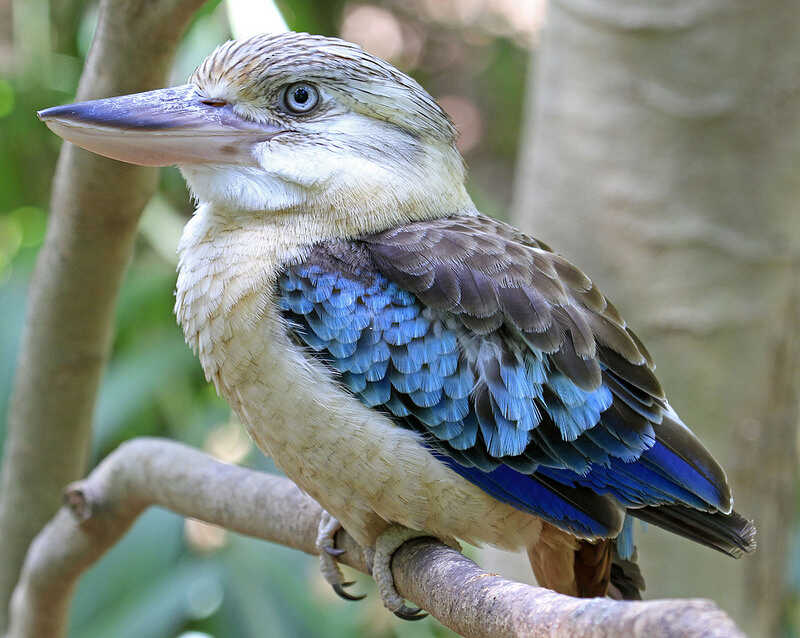
(Todiramphus sanctus) This medium-sized kingfisher lives in mangroves, woodlands, forests, and river valleys of Australia and New Zealand. Its name “sacred” derives from Polynesian for a holy bird with control over the waves. This bird is 20–23 cm long. It has blue-green to turquoise plumage above and white underparts. Its collar feathers are white, it has a black mask and buff lores.
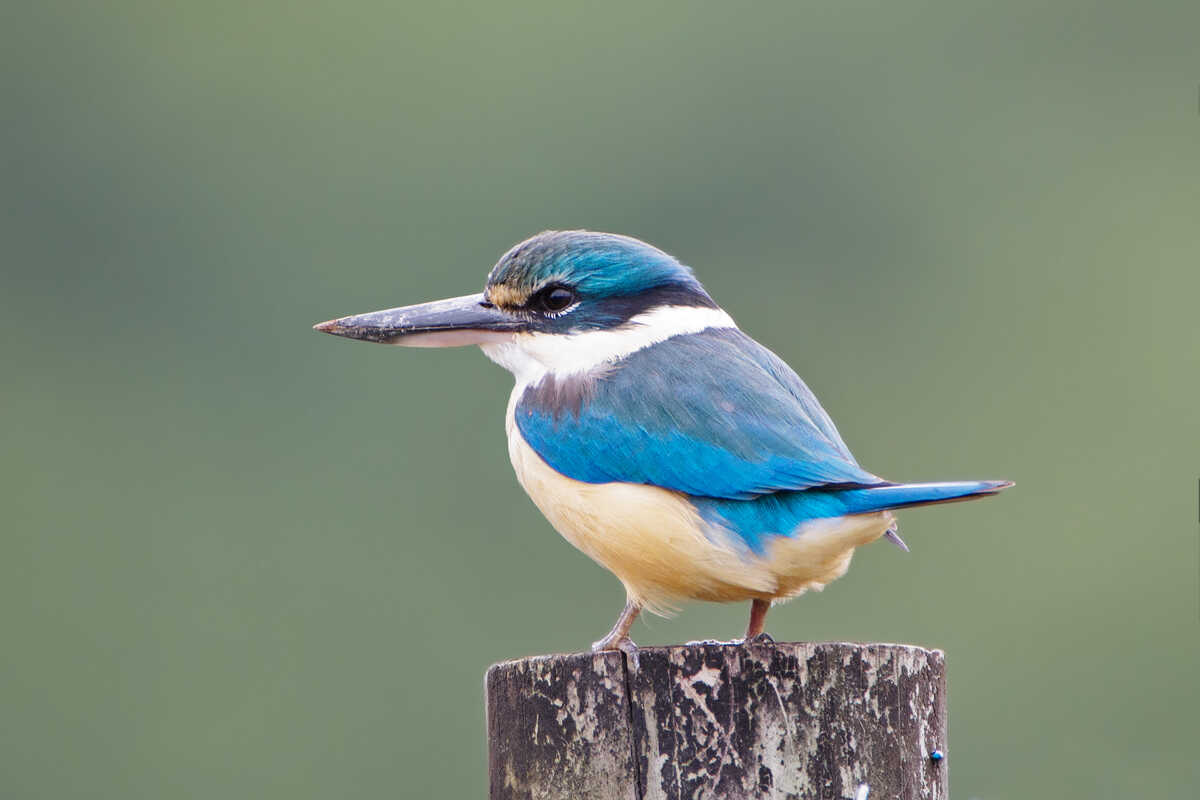
(Malurus cyaneus) It's 14 cm long. Breeding males (in winter or spring) have iridescent blue plumage with black and grey-brown, a brightly coloured crown and ear tufts, a bright-blue forehead, ear coverts, mantle and tail, brown wings, and black throat, eye band, breast, and bill. Females and non-breeding males have plain fawn colour plumage with a lighter underbelly, a fawn tail and a brown bill. Their call is a 1–4 second high-pitched reel.
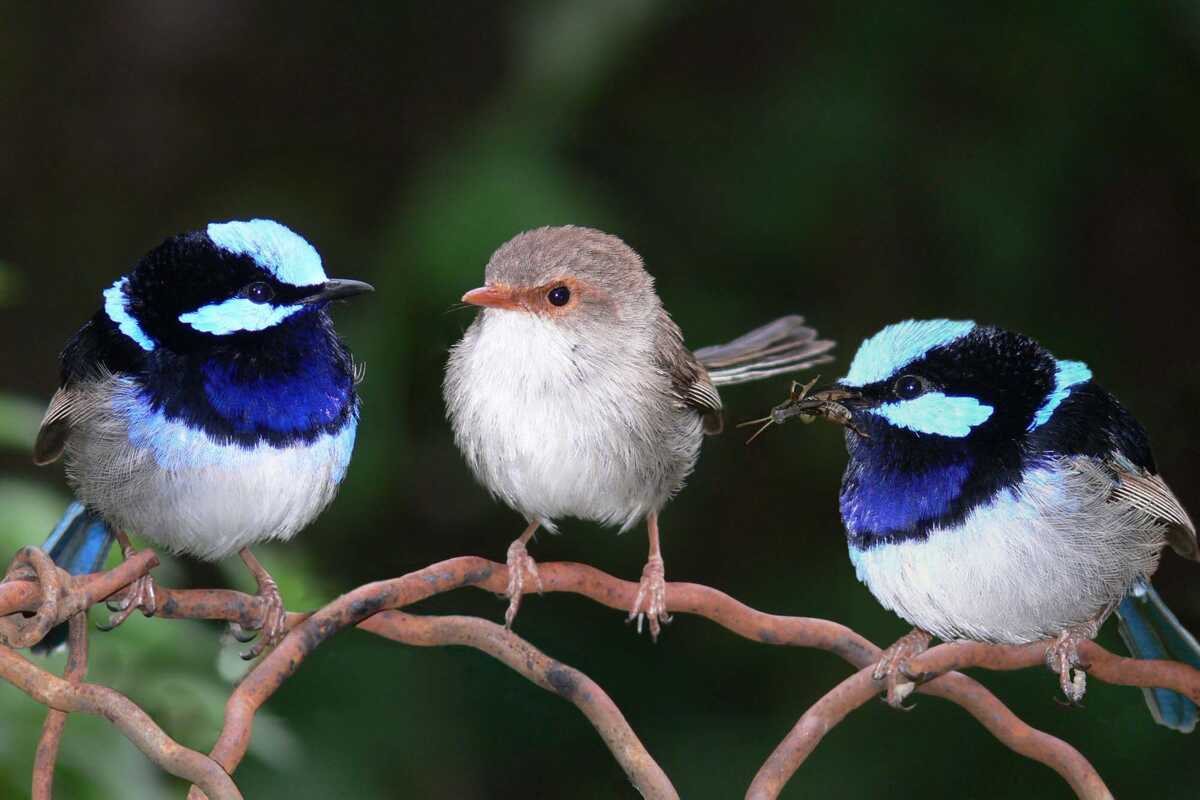
(Malurus lamberti) This bird lives in scrublands east of the Great Dividing Range. It is 14–15 cm long. While breeding, males have brightly coloured chestnut shoulders, azure crowns, and ear coverts. Otherwise, this bird has grey-brown plumage. Males have a black bill, eye-ring, and bare skin between the eyes and the bill. The Female's bill is red-brown with bright red eye-ring. It feeds on insects. This species lives in small groups to defend its territory.
Image by Aviceda
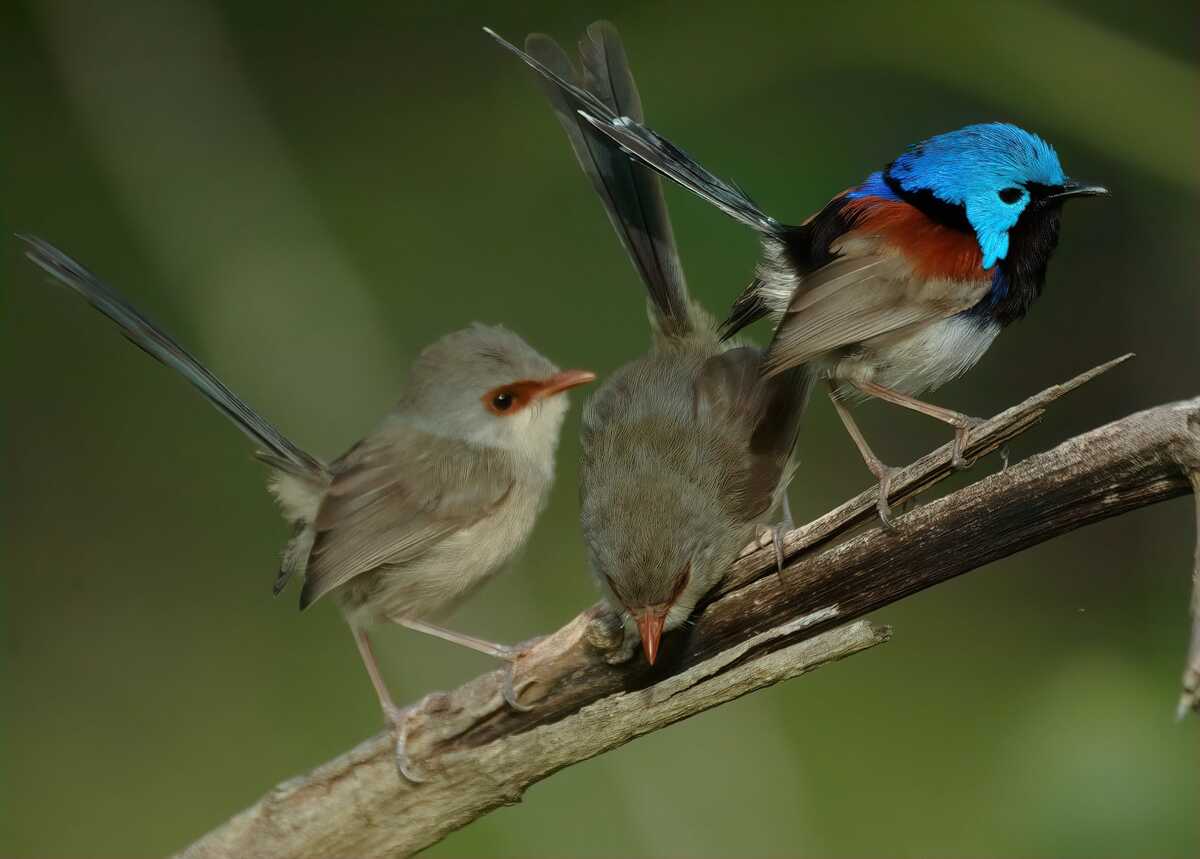
(Smicrornis brevirostris) This is Australia's smallest bird. It is 8 to 9 cm long. It lives in the canopies of dry, open eucalyptus forests and woodlands. It has olive-grey upperparts and paler, more yellowish underparts. It has a faint cream-coloured line around the eyes, a grey throat, and pale brown wings. Its tail is brown and has a black bar and a white spot on the tip of its feathers excluding the central ones. Its bill is short and pale grey which distinguishes it from thornbills. Its voice is loud and clear, either as musical "pee-pee p'wee", "wee bit" or "wee willy weetee".
Image by Patrick_K59
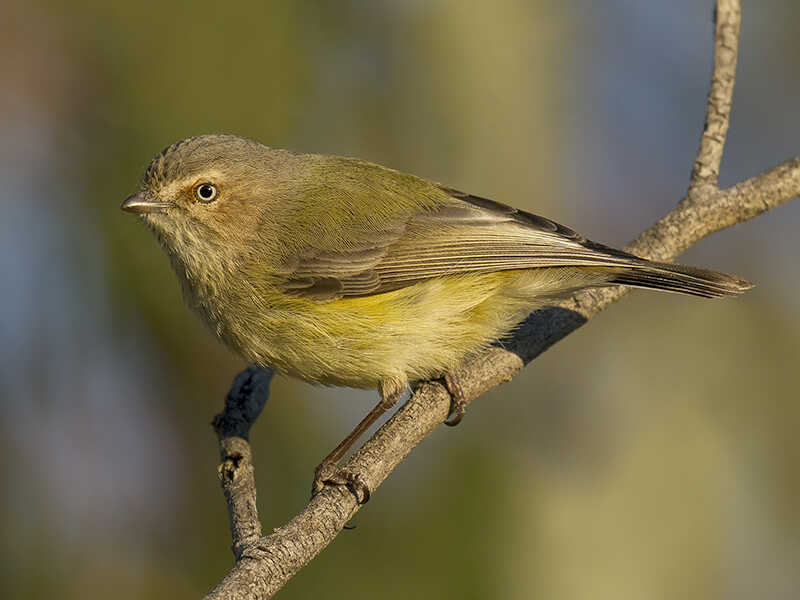
(Acanthiza apicalis) This bird is about 10 cm long. It has a grey-brown plumage on the back, cream-coloured plumage with black streaks on the belly, a reddish rump, and a dark tail that has a white tip. Because of the colouration, it is often confused with the coastal brown thornbill (Acanthiza pusilla). It feeds on small insects. spiders, seeds, and small vegetable matter. It breeds from July to December.
Image by Peter Jacobs
